TENDA TECHNOLOGY F303 Wireless N300 Easy Setup Router User Manual
SHENZHEN TENDA TECHNOLOGY CO., LTD. Wireless N300 Easy Setup Router Users Manual
User Manual
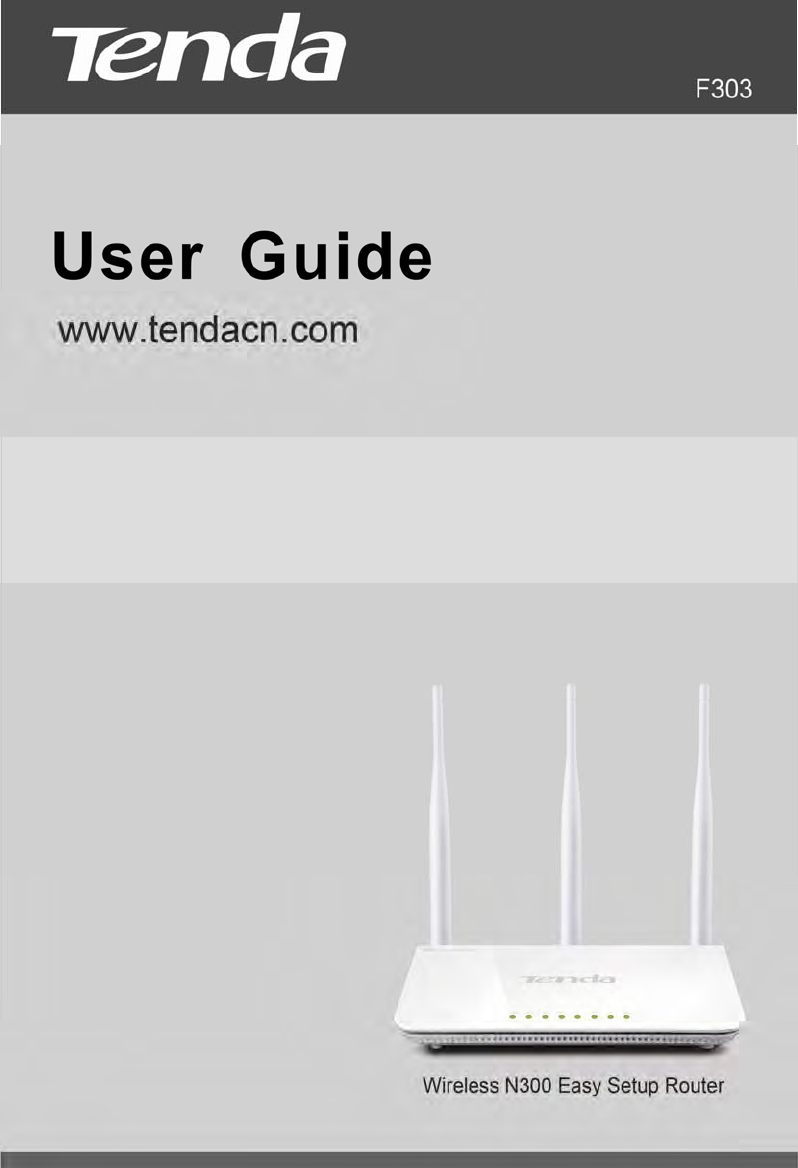

Wireless N300 Easy Setup Router
Copyright Statement
is the registered trademark of Shenzhen Tenda
Technology Co., Ltd. All the products and product names mentioned
herein are the trademarks or registered trademarks of their respective
holders. Copyright of the whole product as integration, including its
accessories and software, belongs to Shenzhen Tenda Technology Co.,
Ltd. Without prior expressed written permission from Shenzhen Tenda
Technology Co., Ltd, any individual or party is not allowed to copy,
plagiarize, reproduce, or translate it into other languages.
All photos and product specifications mentioned in this manual are
for references only. Upgrades of software and hardware may occur;
Tenda reserves the right to revise this publication and to make changes in
the content hereof without obligation to notify any person or organization
of such revisions or changes. If you would like to know more about our
product information, please visit our website at
http://www.tendacn.com.

Wireless N300 Easy Setup Router
Table of Contents
TABLE OF CONTENTS…………………………………………........................3
CHAPTER 1 PRODUCT OVERVIEW……………………………………………………1
1.1 PACKAGE CONTENTS………………………………………………………………………………………………1
1.2 GETTING TO KNOW YOUR ROUTER……………………………………………………………………………1
CHAPTER 2 INSTALLATION AND QUICK SETUP GUIDE…………………………5
2.1 PREPARATION………………………………………………………………………………………………………5
2.2 PHYSICAL INSTALLATION…………………………………………………………………………………………5
2.3 INTERNET CONNECTION SETUP……………………………………………………………………………….7
2.3.1 Use Standard TCP/IP Properties for DHCP……………………………………………………7
2.3.2 Log in to Web Manager………………………………………………………………………………….7
2.3.3 Quick Internet Connection Setup………………………………………………………………….8
2.3.4 Verify Internet Connection Settings………………………………………………………………9
2.3.5 Wireless Settings…………………………………………………………………………………………11
2.3.6 Connect to Device Wirelessly……………………………………………………………………12
CHAPTER 3 ADVANCED SETTINGS…………………………………………………19
3.1 STATUS……………………………………………………………………………………………………………19
3.2 INTERNET CONNECTION SETUP……………………………………………………………………………20
3.2.1 PPPoE……………………………………………………………………………………………………………20
3.2.2 Static IP………………………………………………………………………………………………………21
3.2.3 DHCP……………………………………………………………………………………………………………22
3.2.4 PPTP……………………………………………………………………………………………………………23
3.2.5 L2TP……………………………………………………………………………………………………………24
3.3 MAC CLONE……………………………………………………………………………………………………….25
3.4 WAN SPEED………………………………………………………………………………………………………26
3.5 WAN MEDIUM TYPE……………………………………………………………………………………………26
3.6 LAN SETTINGS……………………………………………………………………………………………………29
3.7 DNS SETTINGS…………………………………………………………………………………………………29
3.8 DHCP……………………………………………………………………………………………………………….30
3.9 DHCP CLIENT LIST……………………………………………………………………………………………31
CHAPTER 4 WIRELESS SETTINGS……………………………………………………33
4.1 WIRELESS BASIC SETTINGS………………………………………………………………………………….33
4.1.1 Wireless AP Mode…………………………………………………………………………………………33
4.1.2 WDS Bridge Mode………………………………………………………………………………………35
4.2 WIRELESS SECURITY……………………………………………………………………………………………43
4.3 WIRELESS ACCESS CONTROL………………………………………………………………………………46
4.4 WIRELESS CLIENT………………………………………………………………………………………………47
CHAPTER 5 BANDWIDTH CONTROL…………………………………………………49
5.1 BANDWIDTH CONTROL…………………………………………………………………………………………49
5.2 TRAFFIC STATISTICS……………………………………………………………………………………………50
CHAPTER 6 SPECIAL APPLICATIONS………………………………………………52
6.1 PORT RANGE FORWARDING…………………………………………………………………………………52

Wireless N300 Easy Setup Router
6.2 DMZ HOST………………………………………………………………………………………………………53
6.3 DDNS………………………………………………………………………………………………………………54
6.4 UPNP………………………………………………………………………………………………………………55
6.5 STATIC ROUTING…………………………………………………………………………………………………56
6.6 ROUTING TABLE…………………………………………………………………………………………………57
CHAPTER 7 SECURITY…………………………………………………………………58
7.1 URL FILTER………………………………………………………………………………………………………58
7.2 MAC FILTER………………………………………………………………………………………………………59
7.3 CLIENT FILTER……………………………………………………………………………………………………61
CHAPTER 8 TOOLS………………………………………………………………………63
8.1 REBOOT……………………………………………………………………………………………………………63
8.2. RESTORE TO FACTORY DEFAULT SETTINGS……………………………………………………………63
8.3 BACK/RESTORE…………………………………………………………………………………………………63
8.4 SYSLOG……………………………………………………………………………………………………………65
8.5 REMOTE WEB-BASED MANAGEMENT………………………………………………………………………65
8.6 TIME…………………………………………………………………………………………………………………66
8.7 LOGIN PASSWORD………………………………………………………………………………………………67
8.8 FIRMWARE UPGRADE……………………………………………………………………………………………67
APPENDIX 1 HOW TO CONFIGURE IP………………………………………………69
WIN7 OS CONFIGURATION……………………………………………………………………………………69
XP OS CONFIGURATION…………………………………………………………………………………………72
APPENDIX 2 GLOSSARY…………………………………………………………………76
APPENDIX 3 FAQS………………………………………………………………………79
APPENDIX 4 REMOVE WIRELESS NETWORK FROM YOUR PC……………81
APPENDIX 5 SAFETY AND EMISSION STATEMENT……………………………84
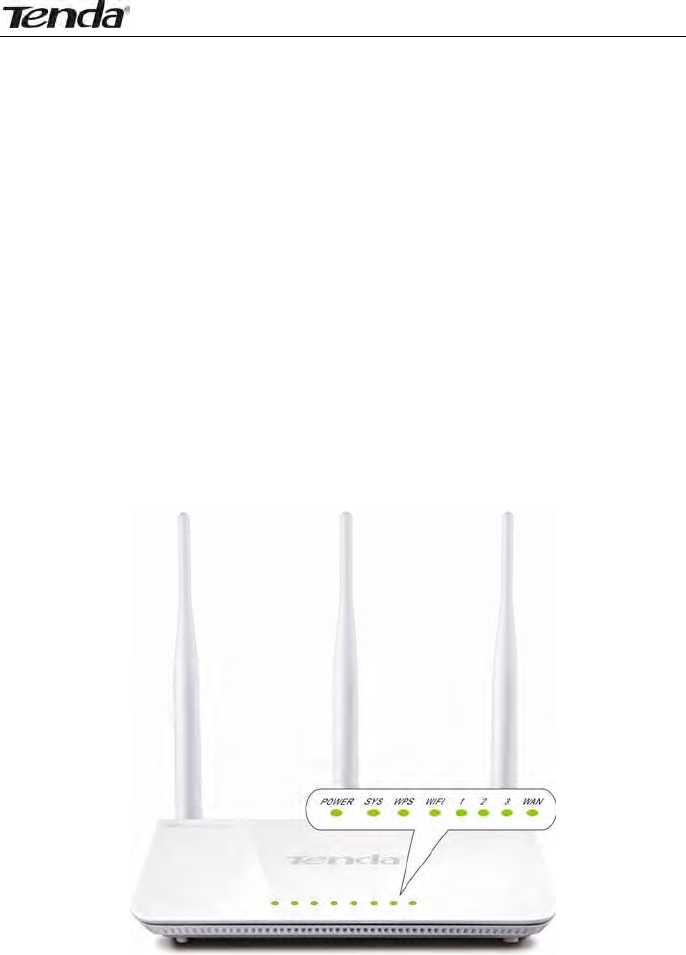
Wireless N300 Easy Setup Router
1
Chapter 1 Product Overview
1.1 Package Contents
Unpack the box and verify the package contains the following items:
Wireless Broadband Router
Power Adapter
Installation Guide
Resource CD(including User Guide, Quick Install Guide, and setup
wizard)
Ethernet Cable
If any of the above items is incorrect, missing, or damaged, please contact
your Tenda reseller for immediate replacement.
1.2 Getting to know your router
Before you cable your router, take a moment to become familiar with the
front and back panels and the label. Pay particular attention to the LEDs on
the front panel.
Front Panel
Front LED Overview

Wireless N300 Easy Setup Router
2
LED Status Description
Solid Indicates a proper connection to the power
supply
Power
Off Indicates an improper connection to the power
adapter
SYS Blinking Indicates system is functioning properly
Solid WPS is enabled
Blinking
Device is performing WPS authentication on a
client device
WPS
Off WPS is disabled or WPS negotiation is finished
Solid Wireless is enabled
Blinking
Transferring data
WIFI
Off Wireless is disabled
Solid LAN port connected correctly
Blinking
LAN port is transferring data
LAN(1/2/3)
Off LAN port connected incorrectly
Solid WAN port connected correctly
Blinking
WAN port is transferring data
WAN
Off WAN port connected incorrectly
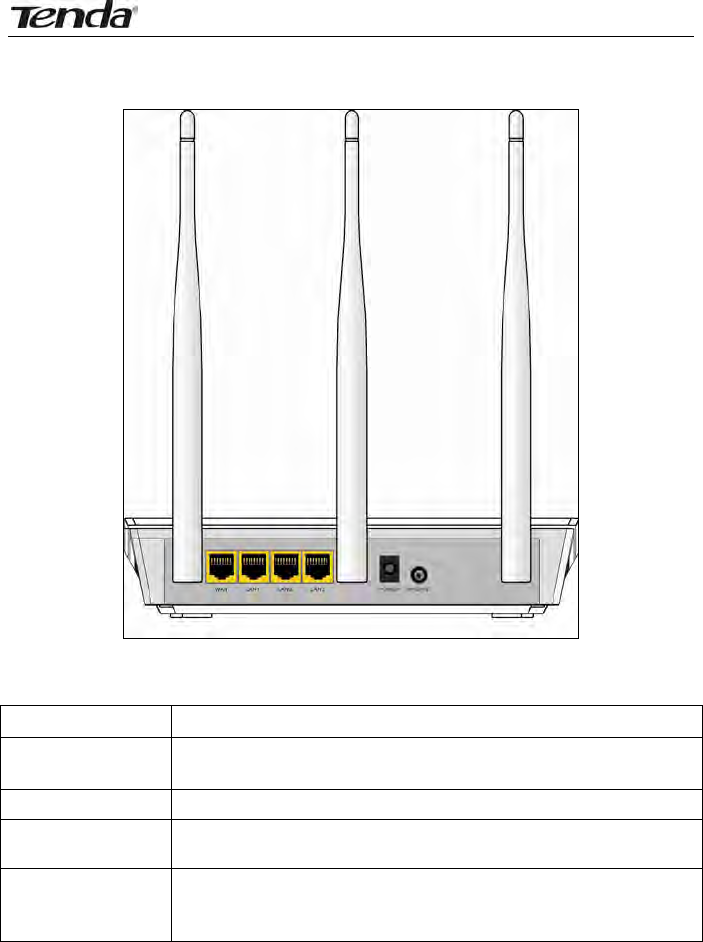
Wireless N300 Easy Setup Router
3
Back Panel
Back LED Overview
Port Description
WA N Usually for connecting DSL MODEM、CABLE MODEM、ISP to
the Internet.
LAN(1/2/3) Usually for connecting computers, switches .etc.
POWER The power adapter is connected and you can use the provided
adapter to supply power.
WPS/ RESET
When you press this button for 7 seconds, files set by the router
will be deleted and restored to default factory settings; for 1 second,
WPS will be enabled and the WPS LED will be blinking accordingly.
1.3 Position your Router
The router lets you access your network from virtually anywhere within the

Wireless N300 Easy Setup Router
4
operating range of your wireless network. However, the operating distance
or range of your wireless connection can vary significantly depending on the
physical placement of your router. For example, the thickness and number of
walls the wireless signal passes through can limit the range. For best results,
place your router:
• Near the center of the area where your computers and other devices
operate, and preferably within line of sight to your wireless devices.
• So it is accessible to an AC power outlet and near Ethernet cables for
wired computers.
• In an elevated location such as a high shelf, keeping the number of
walls and ceilings between the router and your other devices to a minimum.
• Away from electrical devices that are potential sources of interference.
Equipment that might cause interference includes ceiling fans, home
security systems, microwaves, PCs, the base of a cordless phone, or a
2.4-GHz cordless phone.
• Away from any large metal surfaces, such as a solid metal door or
aluminum studs. Large expanses of other materials such as glass, insulated
walls, fish tanks, mirrors, brick, and concrete can also affect your wireless
signal.

Wireless N300 Easy Setup Router
5
Chapter 2 Installation and Quick Setup Guide
2.1 Preparation
Before connecting Ethernet cables,please verify the following items:
Item Description
Wireless Router Used with the provided power supply
PC Installed with IE8 or other better web browsers.
Ethenet Cable Used for linking the PC to the router
Broadband Service Provided by ISP
Internet Connection
Setup
If you connect to the Internet using a broadband
connection that requires a username and a
password provided by your ISP, please select
PPPoE;
If your ISP provides all the needed information:
IP address, subnet mask, gateway address, and
DNS address(es), please select Static IP;
If you can access Internet as soon as your
computer directly connects to an
Internet-enabled ADSL/Cable modem, please
select DHCP;
If your ISP uses a PPTP connection, please select
PPTP;
If your ISP uses an L2TP connection, please
select L2TP..
2.2 Physical installation
1. Connect one end of the included power adapter to the device and plug the
other end into a wall outlet nearby.(Using a power adapter with a different
voltage rating than the one included with the device will cause damage to
the device.)
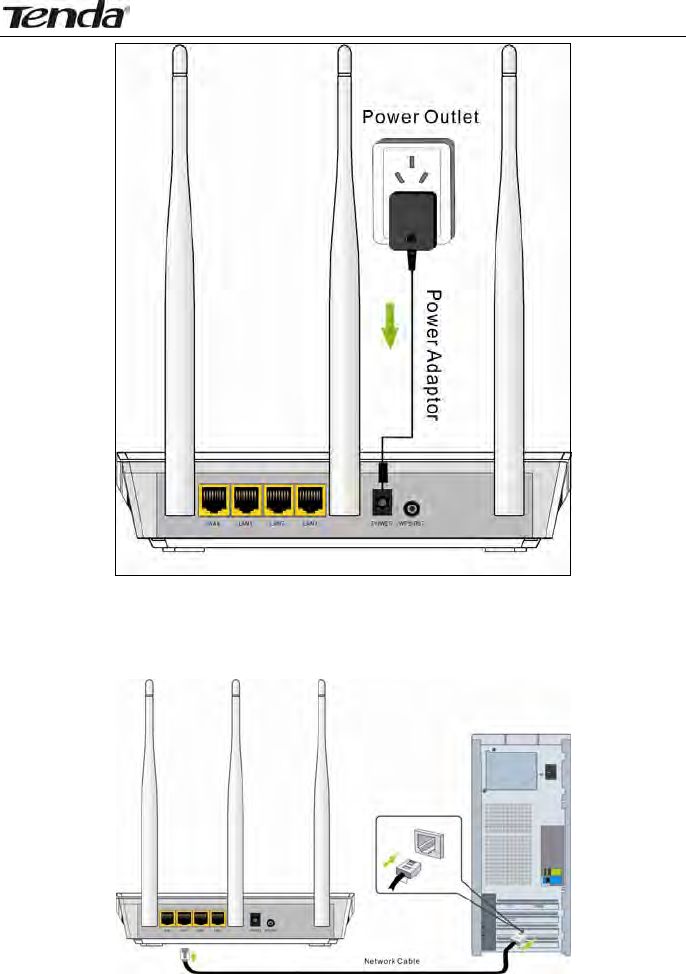
Wireless N300 Easy Setup Router
6
2. Connect one of the LAN ports on the Device to the NIC port on your PC
using an Ethernet cable.
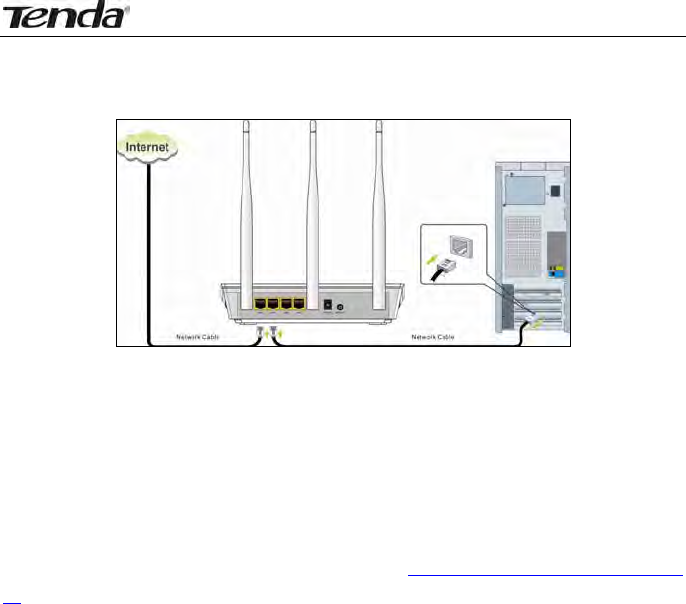
Wireless N300 Easy Setup Router
7
3. Connect the Ethernet cable from Internet side to the WAN port on the
Device.
4. When connected, log in to Web manager to set up Internet connection.
2.3 Internet Connection Setup
Before you start the setup process, get your ISP information and make sure
the computers and devices in the network have the settings described here.
2.3.1 Use Standard TCP/IP Properties for DHCP
If you set up your computer to use a static IP address, change the settings
so that it uses Dynamic Host Configuration Protocol (DHCP). If you are not
clear about this configuration, please refer to Appendix 1: How to Configure
IP.
.
2.3.2 Log in to Web Manager
1. 1). Launch a web browser; in the address bar, input 192.168.0.1 and
press Enter;
2). Enter admin in the password field on the appearing login window and
then click OK.
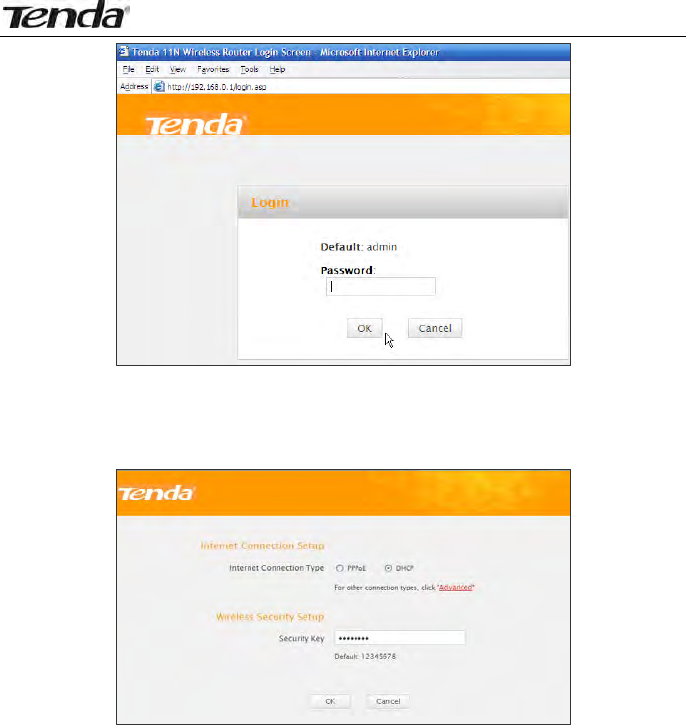
Wireless N300 Easy Setup Router
8
2. Now you may access the device’s home page for quickly setting up
Internet connection and wireless security.
2.3.3 Quick Internet Connection Setup
2 common Internet connection types are available on the home page:
PPPoE and DHCP.
DHCP: Select DHCP (Dynamic IP) if you can access Internet as soon as your
computer directly connects to an Internet-enabled ADSL/Cable modem;
configure a security key (8-63 characters) to secure your wireless network
and then click OK.
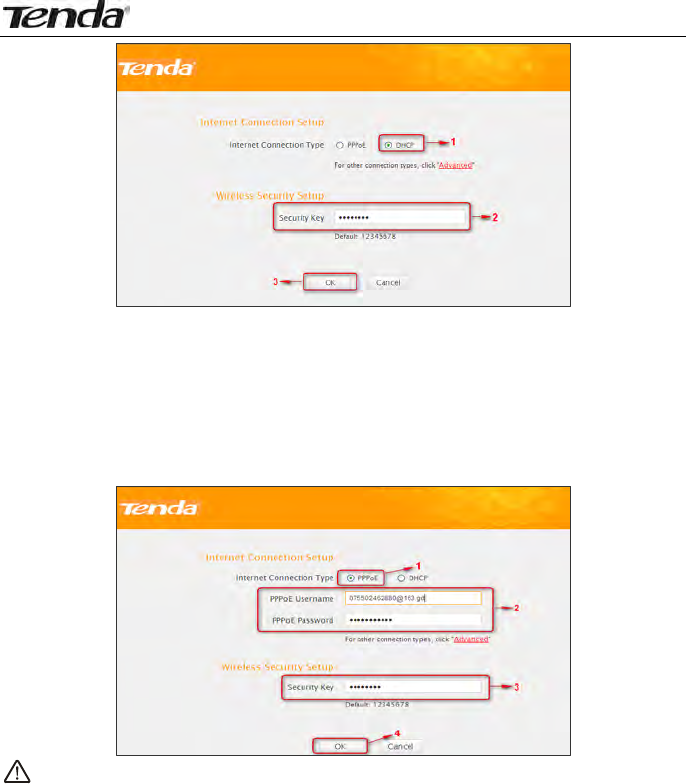
Wireless N300 Easy Setup Router
9
PPPoE: Select PPPoE (Point to Point Protocol over Ethernet) if you used to
connect to the Internet using a broadband connection that requires a
username and a password. Enter the user name and password provided by
your ISP; configure a security key to secure your wireless network and then
click OK.
Note:
1. DHCP is the default Internet connection type;
2. If you are not sure about your PPPoE username and password, contact
your Internet service provider (ISP) for help. For other Internet
connection types, please go to section 3.2: Internet Connection Setup.
2.3.4 Verify Internet Connection Settings
System automatically skips to the status page when you finish all needed
settings on the home page. Here you can see the system status and WAN
connection status of the device.
1. If you find "Connected" and a WAN IP address displayed there (as
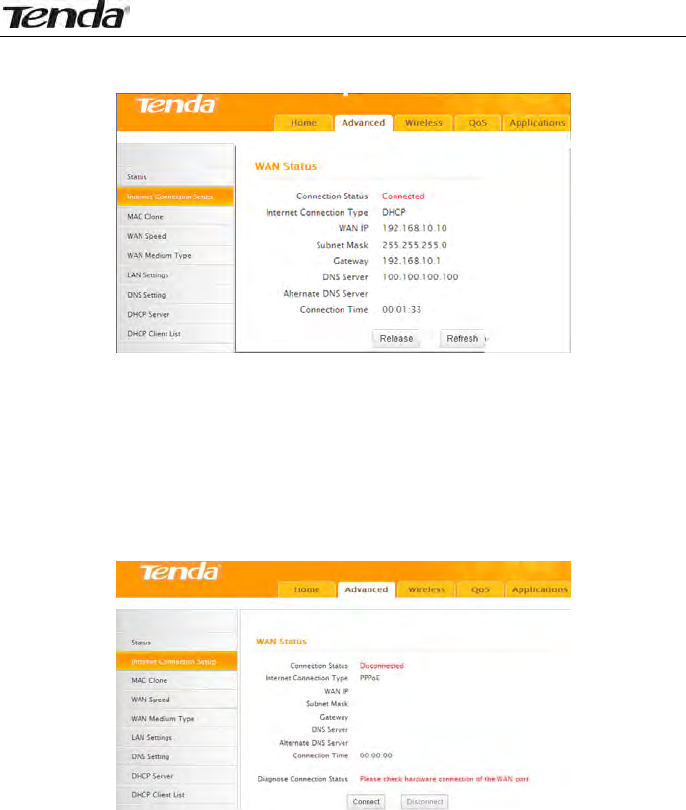
Wireless N300 Easy Setup Router
10
shown below), you have got a wired internet access now.
2. If connection status displays "Disconnected" and there is no WAN IP
address displayed (as seen below), connection between the
Internet-enabled modem and your device may have failed. Please
double check or re-connect all involved devices and cables properly and
then refresh the page. If nothing is wrong, "Connecting" or "Connected"
will be displayed.
3. If "Connecting" is displayed and no WAN IP address is seen, try
refreshing the page five times. And if it still displays "Connecting" try
steps below:
1). Contact your ISP for assistance if you are using the DHCP connection
type.
2). Read the connection diagnostic info on WAN status.
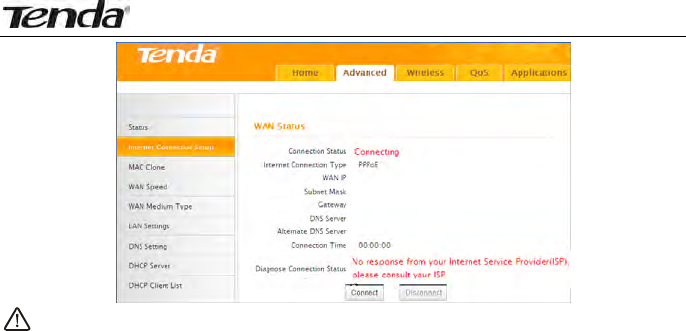
Wireless N300 Easy Setup Router
11
Note:
Below diagnostic info will be displayed on particular occasions for your
reference:
1). You have connected to Internet successfully.
2). You might have entered a wrong user name and/or a wrong password.
Please contact your ISP for the correct user name and password and
enter them again.
3). Ethernet cable is not connected or not properly connected to the WAN
port on the device. Please reconnect it properly.
4). No response is received from your ISP. Please verify that you can access
Internet when you directly connect your PC to an Internet-enabled
modem. If not, contact your local ISP for help.
2.3.5 Wireless Settings
Wireless Basic Settings
If you want to create a WLAN for sharing Internet connection, simply click
Wireless-> Wireless Basic Settings. Change the SSID, you can name it
whatever you like. Select 2437MHz (channel 6) and leave other options
unchanged and then click OK.
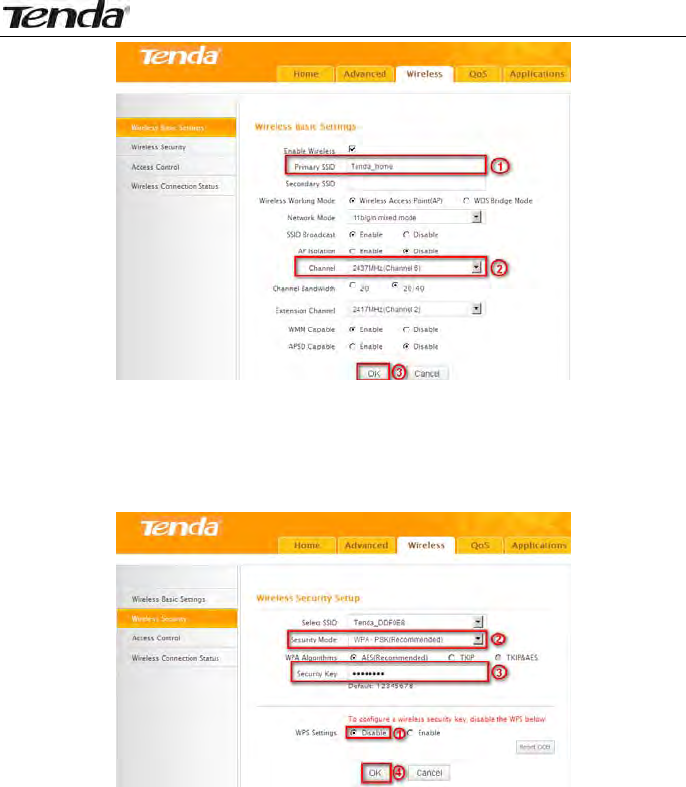
Wireless N300 Easy Setup Router
12
Wireless Security Settings
If you want to encrypt your wireless network, click Wireless Security,
disable WPS, specify a security key of down to 8 characters, and then click
OK.
2.3.6 Connect to Device Wirelessly
Having finished above settings, you can search the device's wireless network
(SSID) from your wireless devices (notebook, iPad, iPhone, etc) and enter a
security key to connect to it wirelessly.
1. If you are using Windows XP OS, do as follows:
1) Click Start and select Control Panel.
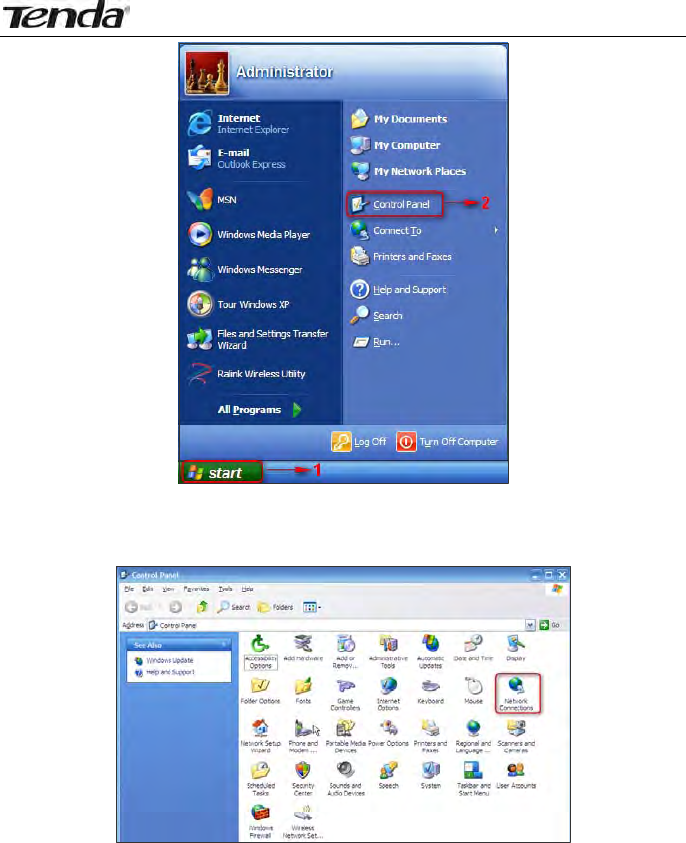
Wireless N300 Easy Setup Router
13
2) Click Network Connections.
3) Right click Wireless Network Connection and then select View
Available Wireless Networks.
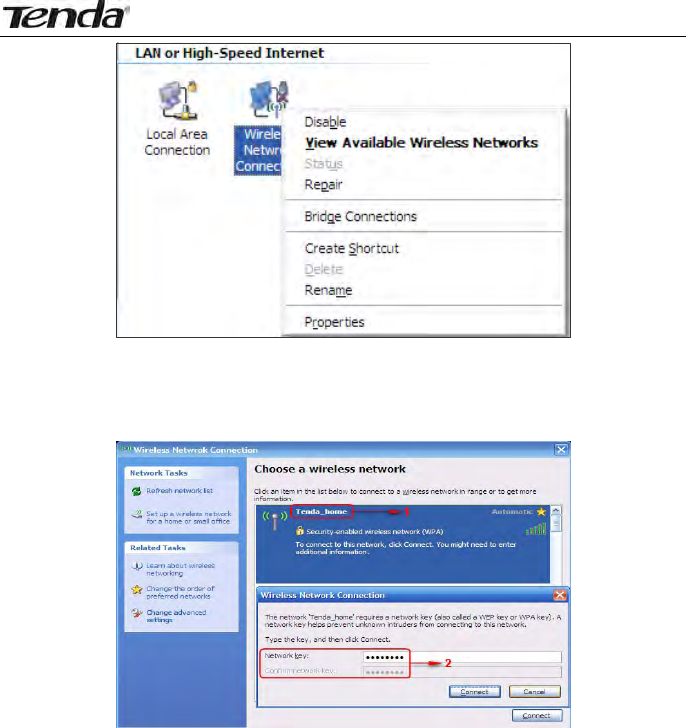
Wireless N300 Easy Setup Router
14
4) Select the desired wireless network, click Connect, enter the security
key and then click OK.
5) You can access Internet via the device when "Connected" appears next
to the wireless network name you selected.
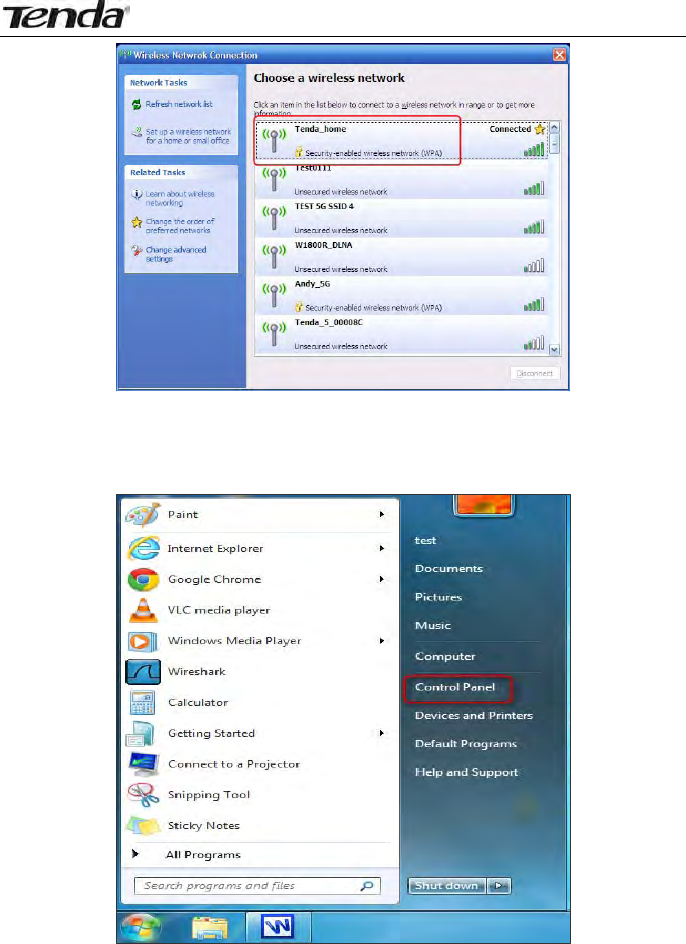
Wireless N300 Easy Setup Router
15
2. If you are using Windows 7 OS, do as follows:
1) Click Start and select Control Panel.
2) Click Network and Internet.
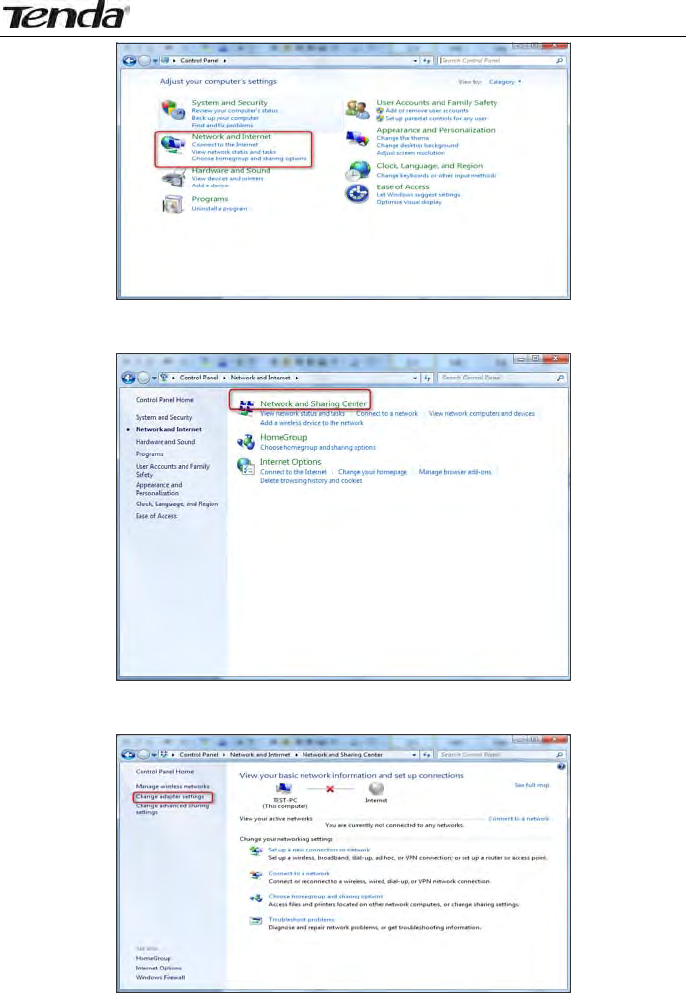
Wireless N300 Easy Setup Router
16
3) Click Network and Sharing Center.
4) Click Change adapter settings.
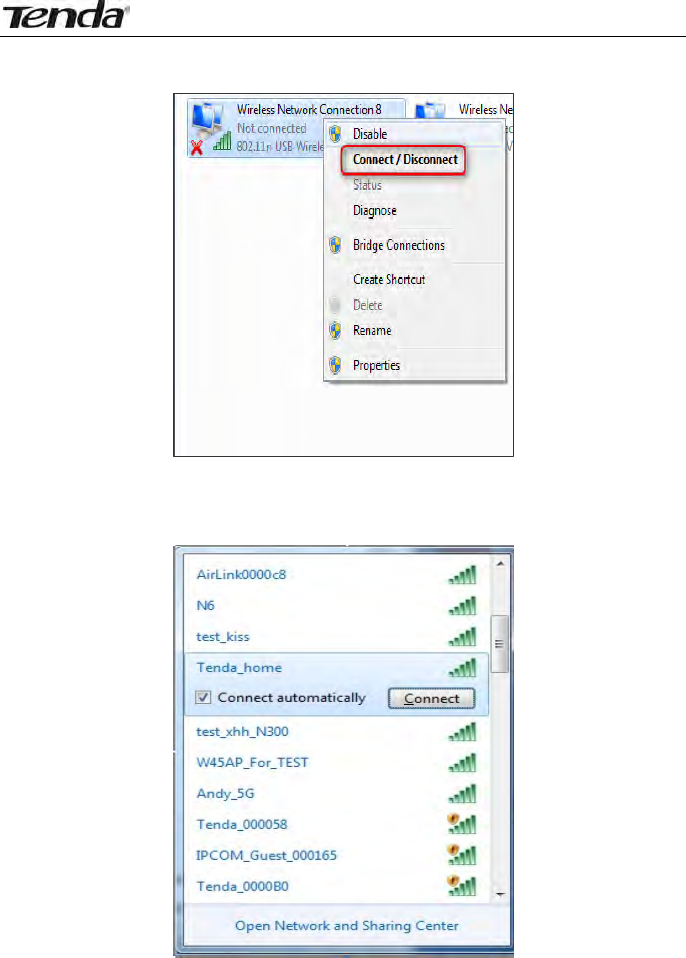
Wireless N300 Easy Setup Router
17
5) Select a desired wireless connection and click Connect/Disconnect.
6) Select the wireless network you wish to connect and click Connect.
7) Enter the security key and click OK.
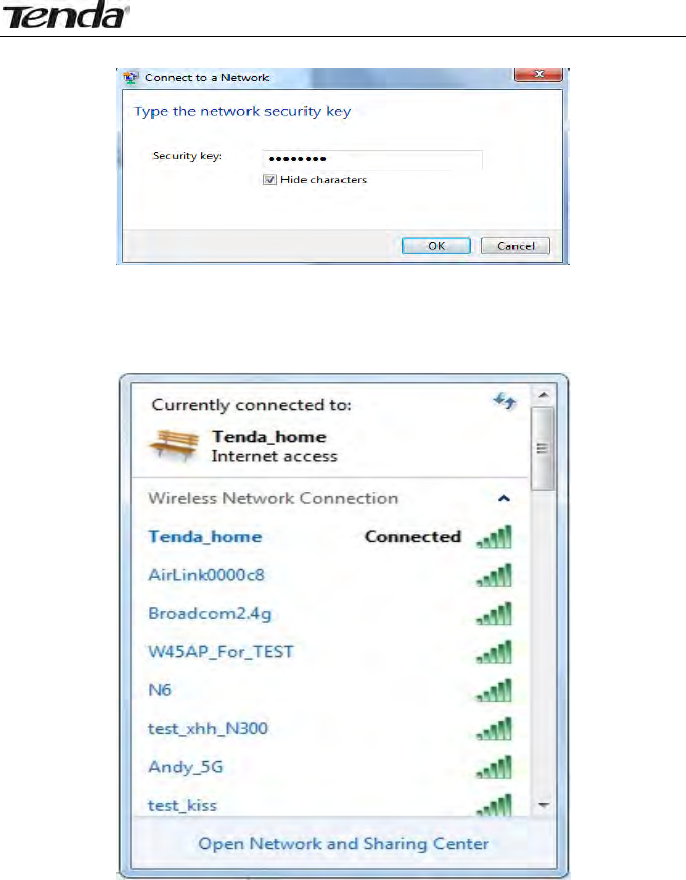
Wireless N300 Easy Setup Router
18
8) You can access Internet via the device when "Connected" appears next
to the wireless network name you selected.
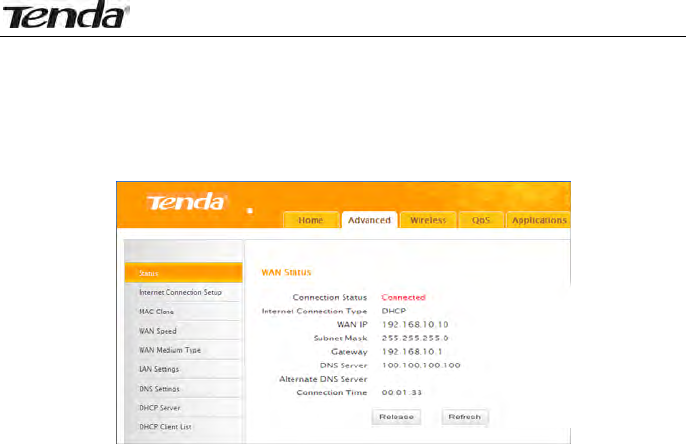
Wireless N300 Easy Setup Router
19
Chapter 3 Advanced Settings
3.1 Status
Here you can see at a glance the operating status of the device.
1. Connection Status: Displays WAN connection status: Disconnected,
Connecting or Connected.
2. Disconnected: Indicates that the Ethernet cable from your ISP side is
not correctly connected to device's WAN port or the router is not logically
connected to your ISP.
3. Connecting: Indicates that the WAN port is correctly connected and is
requesting an IP address from your ISP.
4. Connected: Indicates that the router has been connected to your ISP.
5. Internet Connection Type: Displays current Internet connection type.
6. WAN IP: Displays the WAN IP address.
7. Subnet Mask: Displays WAN subnet mask provided by your ISP.
8. Gateway: Displays WAN gateway address.
9. DNS Server: Displays the preferred WAN DNS address.
10. Alternate DNS Server: Displays the alternate WAN DNS address if any.
11. Connection Time: Time duration since the device has been successfully
connected to ISP.
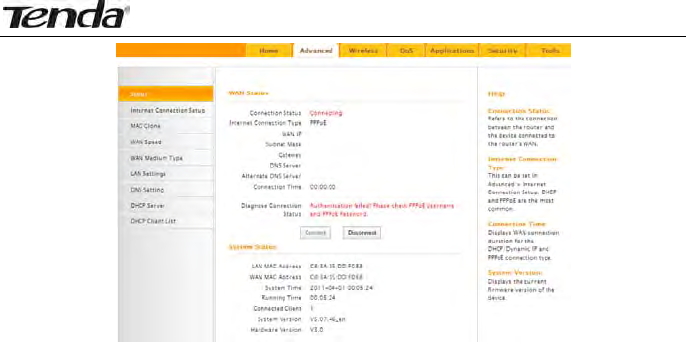
Wireless N300 Easy Setup Router
20
1. LAN MAC Address: Displays device’s LAN MAC address.
2. WAN MAC Address: Displays device’s WAN MAC address.
3. System Time: Displays device’s system time either customized or
obtained from Internet.
4. Up Time: Displays device's uptime.
5. Connected Client(s): Displays the number of connected network
devices (which obtain IP addresses from device DHCP server).
6. Firmware Version: Displays Device’s current firmware version.
7. Hardware Version: Displays Device’s current hardware version.
3.2 Internet Connection Setup
3.2.1 PPPoE
Select PPPoE (Point to Point Protocol over Ethernet) if you used to connect to
the Internet using a broadband connection that requires a username and a
password and enter the user name and password provided by your ISP.
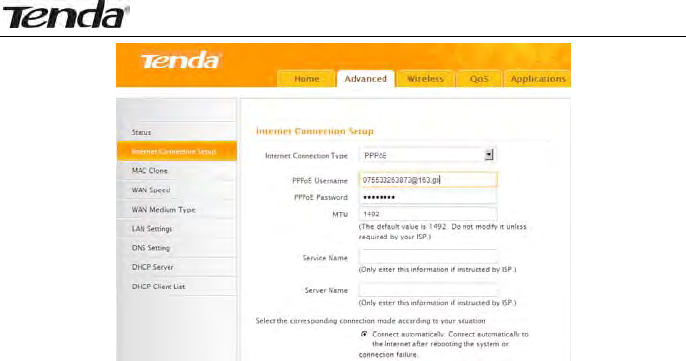
Wireless N300 Easy Setup Router
21
1. Internet connection Type: Select PPPoE.
2. PPPoE User Name: Enter the User Name provided by your ISP.
3. PPPoE Password: Enter the password provided by your ISP.
4. MTU: Maximum Transmission Unit. DO NOT change it from the factory
default of 1492 unless necessary. You may need to change it for optimal
performance with some specific websites or application software that
cannot be opened or enabled; in this case, try 1450, 1400, etc.
5. Service Name: Description of PPPoE connection. Leave blank unless
otherwise required.
6. Server Name: Description of server. Leave blank unless otherwise
required.
7. Connect Automatically: Connect automatically to the Internet after
rebooting the system or connection failure.
Connect Manually: Require the user to manually connect to the Internet
before each session.
Connect On Demand: Re-establish connection to the Internet only when
there is data transmission.
Connect During Specified Time Period: Only connect to Internet during
a specified time period.
8. OK: Click it to save all your settings.
3.2.2 Static IP
Select Static IP if your ISP provides all the needed info. You will need to
enter the provided IP address, subnet mask, gateway address, and DNS
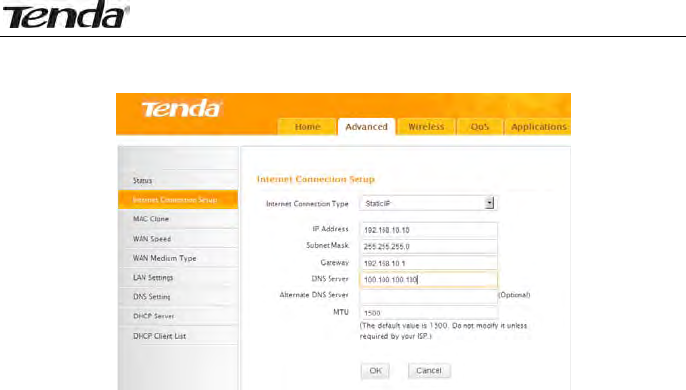
Wireless N300 Easy Setup Router
22
address(es) in corresponding fields.
1. Internet connection Type: Select Static IP.
2. IP Address: Enter the IP address provided by your ISP. Consult your
ISP if you are not clear.
3. Subnet mask: Enter the subnet mask provided by your ISP.
4. Gateway: Enter the WAN Gateway provided by your ISP. Consult your
ISP if you are not clear.
5. DNS Server: Enter the DNS address provided by your ISP.
6. Alternate DNS Server: Enter the other DNS address if your ISP
provides 2 such addresses (optional).
7. OK: Click it to save all your settings.
3.2.3 DHCP
Select DHCP (Dynamic IP) if you can access Internet as soon as your
computer directly connects to an Internet-enabled ADSL/Cable modem.
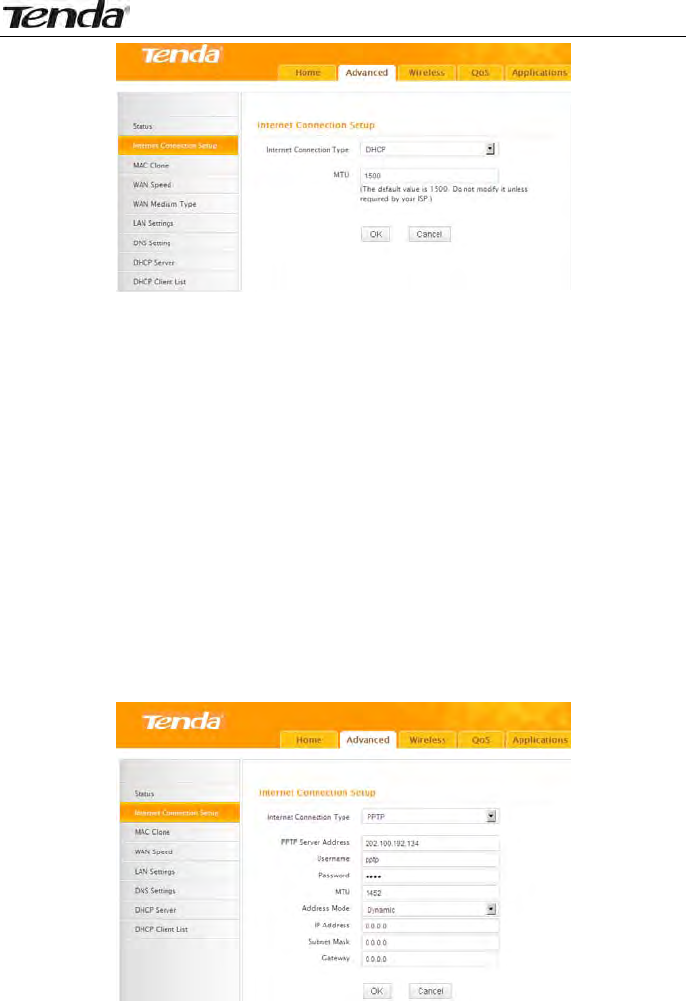
Wireless N300 Easy Setup Router
23
1. Internet connection Type: Select DHCP.
2. MTU: Maximum Transmission Unit. DO NOT change it from the factory
default of 1500 unless instructed by your ISP. You may need to change it
for optimal performance with some specific websites or application
software that cannot be opened or enabled; in this case, try 1450, 1400,
etc.
3. OK: Click it to save your settings.
3.2.4 PPTP
PPTP: Select PPTP (Point-to-Point-Tunneling Protocol) if your ISP uses a PPTP
connection. The PPTP allows you to connect a router to a VPN server.
For example:
A corporate branch and headquarter can use this connection type to
implement mutual and secure access to each other’s resources.
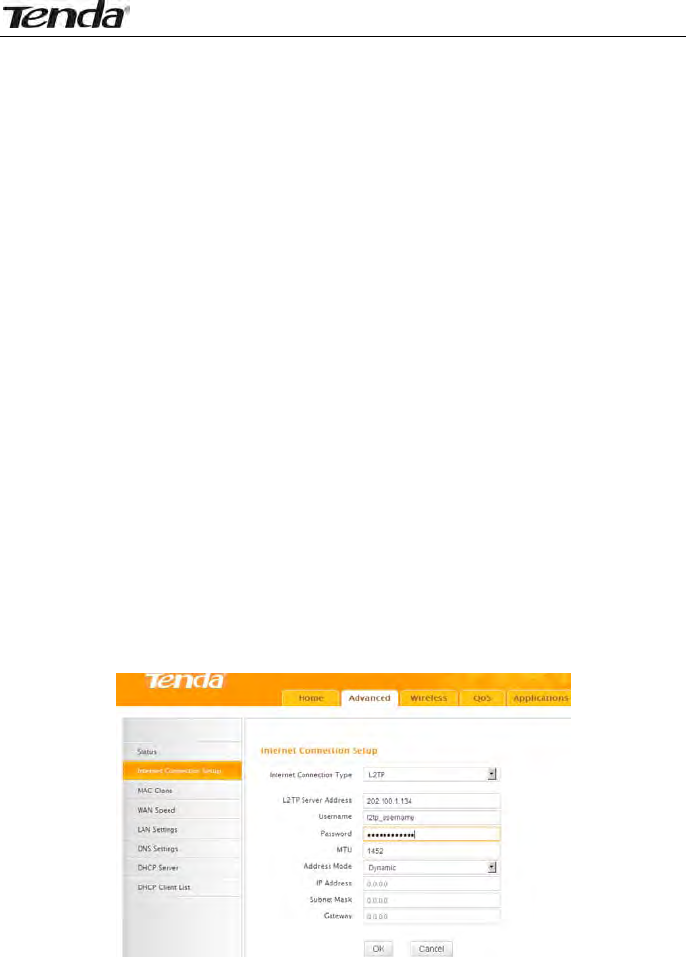
Wireless N300 Easy Setup Router
24
1. Internet connection Type: Displays the current Internet connection
type.
2. PPTP Server Address: Enter the IP address of a PPTP server.
3. User Name: Enter your PPTP User Name.
4. Password: Enter the password.
5. MTU: Maximum Transmission Unit. DO NOT change it from the factory
default of 1492 unless instructed by your ISP. You may need to change it
for optimal performance with some specific websites or application
software that cannot be opened or enabled; in this case, try 1450, 1400,
etc.
6. Address Mode: Select "Dynamic" if you don’t get any IP info from your
ISP, otherwise select "Static". Consult your ISP if you are not clear.
7. IP Address: Enter the IP address provided by your ISP. Consult your
ISP if you are not clear.
8. Subnet mask: Enter the subnet mask provided by your ISP.
9. Gateway: Enter the WAN Gateway provided by your ISP. Consult your
ISP if you are not clear.
3.2.5 L2TP
Select L2TP (Layer 2 Tunneling Protocol) if your ISP uses an L2TP connection.
The L2TP connects your router to a L2TP server.
For Example:
A corporate branch and headquarter can use this connection type to
implement mutual and secure access to each other’s resources.
1. Internet connection Type: Displays the current Internet connection
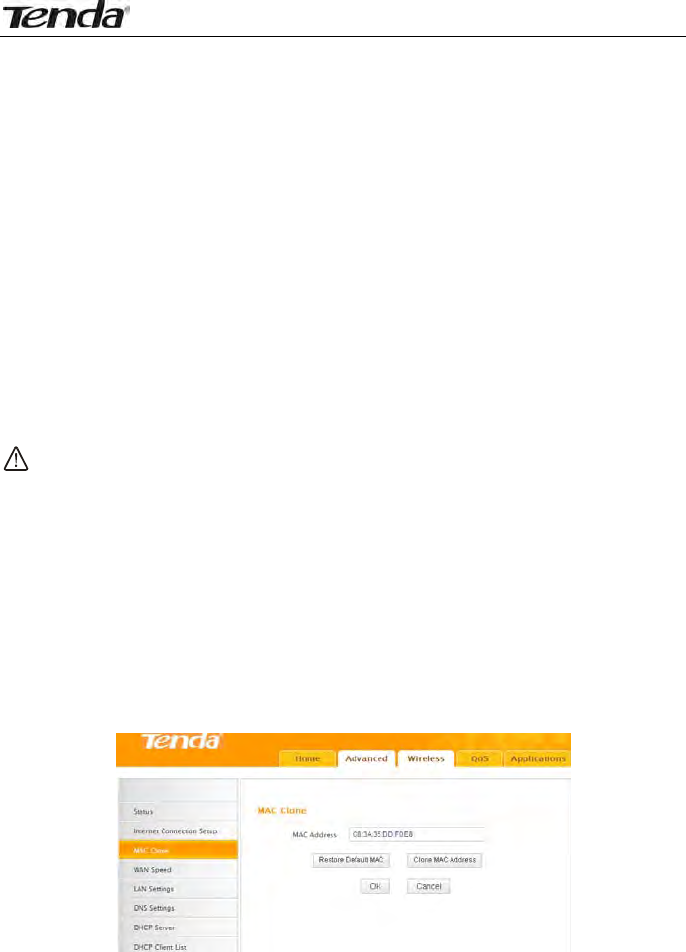
Wireless N300 Easy Setup Router
25
type.
2. L2TP Server Address: Enter the IP address of a L2TP server.
3. User Name: Enter your L2TP username.
4. Password: Enter the password.
5. MTU: Maximum Transmission Unit. DO NOT change it from the factory
default of 1492 unless instructed by your ISP. You may need to change it
for optimal performance with some specific websites or application
software that cannot be opened or enabled; in this case, try 1450, 1400,
etc.
6. Address Mode: Select "Dynamic" if you don’t get any IP info from your
ISP, otherwise select "Static". Consult your ISP if you are not clear.
7. IP Address: Enter the IP address provided by your ISP. Consult your
ISP if you are not clear.
8. Subnet mask: Enter the subnet mask provided by your ISP.
9. Gateway: Enter the WAN Gateway provided by your ISP. Consult your
ISP if you are not clear.
Note:
1. PPPOE, PPTP and L2TP cannot be used simultaneously!
2. For PPTP and L2TP Internet connections, only Static IP or Dynamic
IP is available.
3. Note that PPTP and L2TP may not be available on some products.
3.3 MAC Clone
This section allows you to configure Device’s WAN MAC address.
1. MAC Address: Config device’s WAN MAC address.
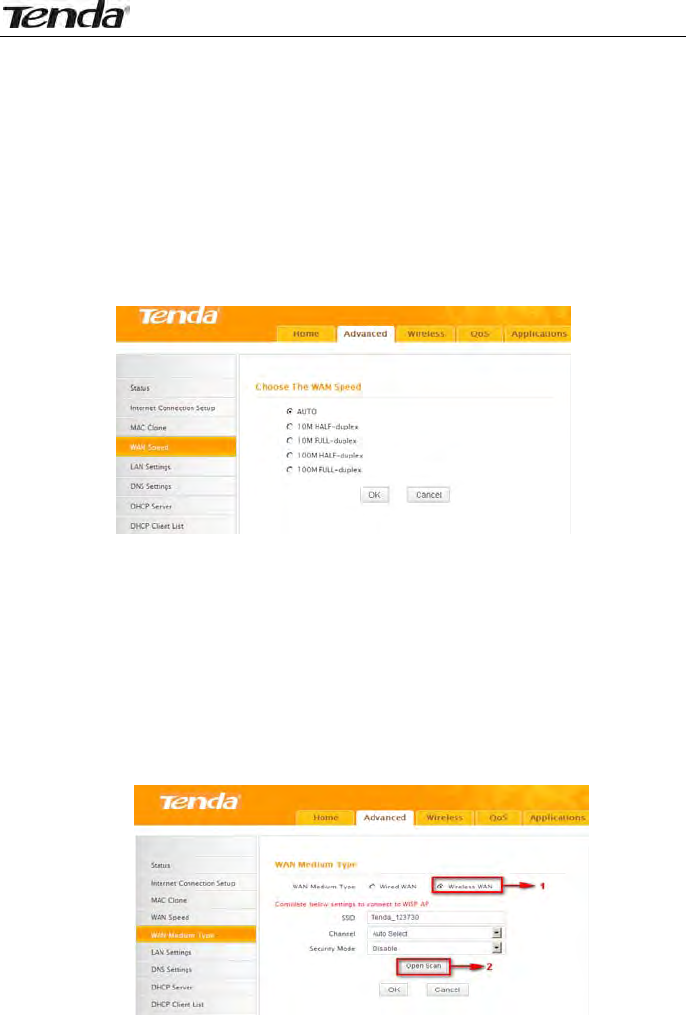
Wireless N300 Easy Setup Router
26
2. Clone MAC Address: Click to copy your PC's MAC address to the device
as a new WAN MAC address.
3. Restore Default MAC: Reset device’s WAN MAC to factory default.
3.4 WAN Speed
Here you can set the speed and duplex mode for WAN port. It is advisable to
keep the default Auto setting to get the best speed.
3.5 WAN Medium Type
The device supports two WAN medium types: wired and wireless. Select
Wired WAN if you need to connect to your ISP via an Ethernet cable or select
Wireless WAN if you directly connect to your WISP wirelessly. The default
WAN Medium Type is Wired WAN, so no settings are required here if you
connect to your ISP via an Ethernet cable. If you connect to your WISP
wirelessly, do as follows:
1. Select Wireless WAN and enable the scan feature.
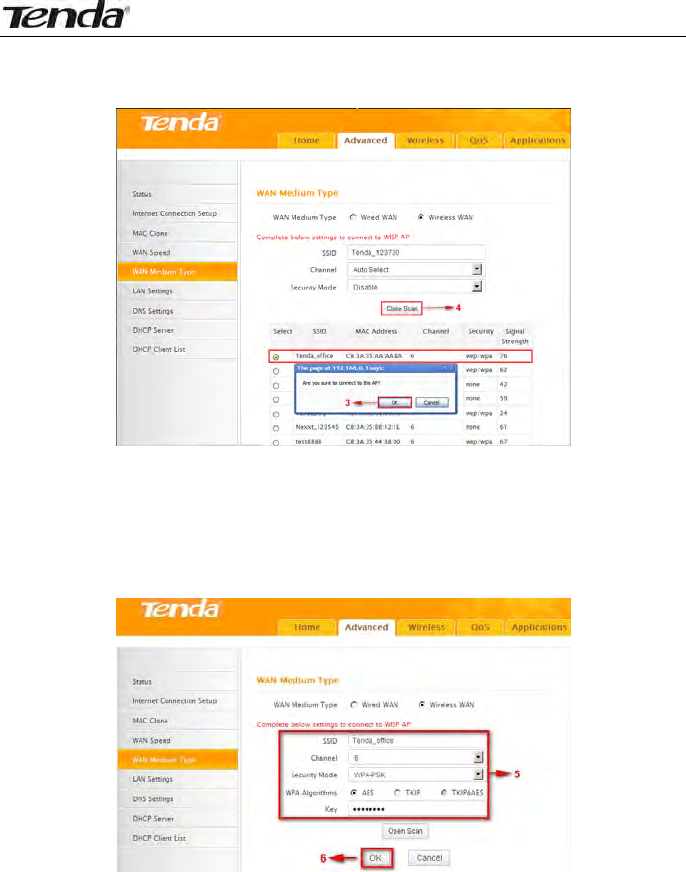
Wireless N300 Easy Setup Router
27
2. Select the wireless network you wish to connect, say, Tenda_office,
and click OK. Then close scan.
3. 1). Verify that SSID and channel on this page are exactly the same as
they are on the uplink wireless network you just selected.
2). Configure the same security mode, security key, cipher type (or WPA
Algorithm) as they are on the uplink wireless network you just
selected. Click OK.
1. WAN Medium Type: Select the WAN medium type you are going to
use.
2. Open Scan (or Scan): Click to search for available wireless networks
in the area and select the one you wish to connect.
3. SSID: The wireless network name of the uplink wireless device.
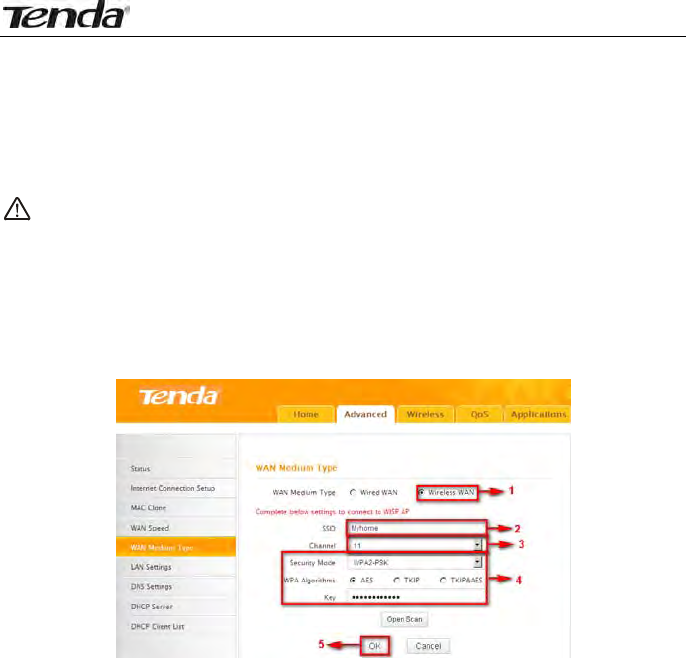
Wireless N300 Easy Setup Router
28
4. Channel: The channel used by the uplink wireless device.
5. Security Mode: The security mode used by the uplink wireless device.
6. WPA Algorithms (or Cipher Type): The WPA Algorithm (or Cipher
Type) used by the uplink wireless device.
7. Key (or Security Key): The security key used by the uplink wireless
device.
8. OK: Click this button and the router will restart to save your settings.
Note: If you change the device’s LAN IP address, you must use the new
one to log on to the web-based configuration utility.
For example:
If SSID, security mode, cipher type (WPA Algorithm), security key and
channel your WISP AP are respectively Myhome, WPA2-PSK,AES,
Tenda_router and 11, then simply enter them in corresponding fields as
seen below.
Or you can use the Open Scan (or Scan) option to have the SSID and
channel of the uplink wireless device automatically copied to this page.
When you finish all these settings, go to Advanced-> Internet
Connection Setup and select a proper Internet connection type (If your
ISP is using a DHCP connection, simply select DHCP).
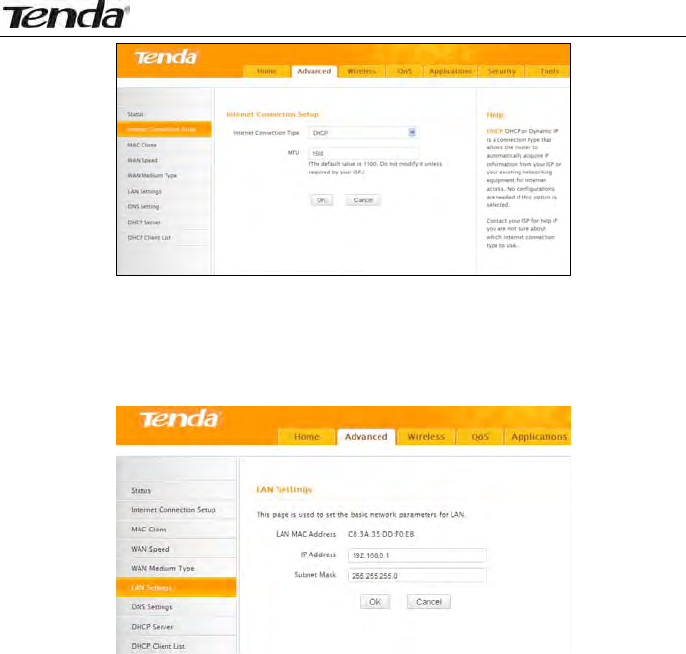
Wireless N300 Easy Setup Router
29
3.6 LAN Settings
Click Advanced -> LAN Settings to enter the screen below.
1. LAN MAC Address: Displays device's LAN MAC address, which is NOT
changeable.
2. IP Address: Device's LAN IP address. The default is 192.168.0.1. You
can change it according to your need.
3. Subnet Mask: Device’s LAN subnet mask, 255.255.255.0 by default.
4. OK: Click to save your settings.
3.7 DNS Settings
DNS is short for Domain Name System or Domain Name Service.
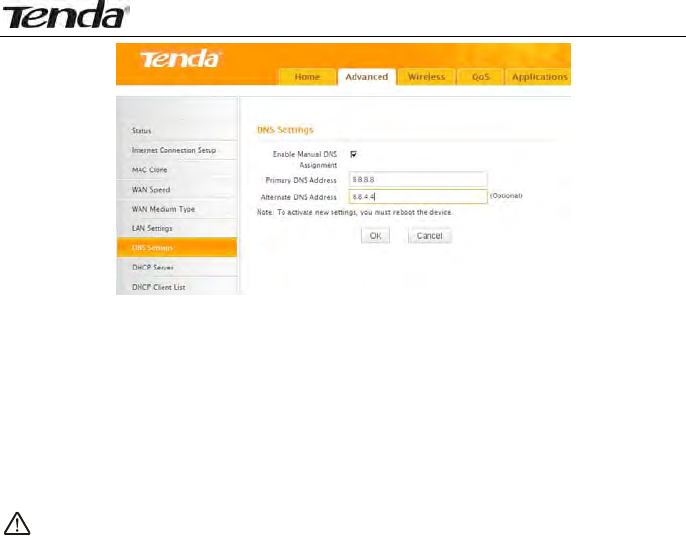
Wireless N300 Easy Setup Router
30
1. Enable Manual DNS Assignment: Check to activate DNS settings.
2. Primary DNS Server:Enter the primary DNS address provided by
your IPS.
3. Alternate DNS Server:Enter the other DNS address if your ISP
provides 2 such addresses (optional).
4. OK: Click to save your settings.
Note:
1. Web pages are not able to open if DNS server addresses are entered
incorrectly.
2. Do remember to restart the device to activate new settings when you
finish all settings.
3.8 DHCP
The Dynamic Host Configuration Protocol (DHCP) is an automatic
configuration protocol used on IP networks. If you enable the built-in DHCP
server on the device, it will automatically configure the TCP/IP settings for all
your LAN computers (including IP address, subnet mask, gateway and DNS
etc), eliminating the need of manual intervention. Just be sure to set all
computers on your LAN to be DHCP clients by selecting "Obtain an IP
Address Automatically" respectively on each such PC. When turned on,
these PCs will automatically load IP information from the DHCP server. (This
feature is enabled by default. Do NOT disable it unless necessary)
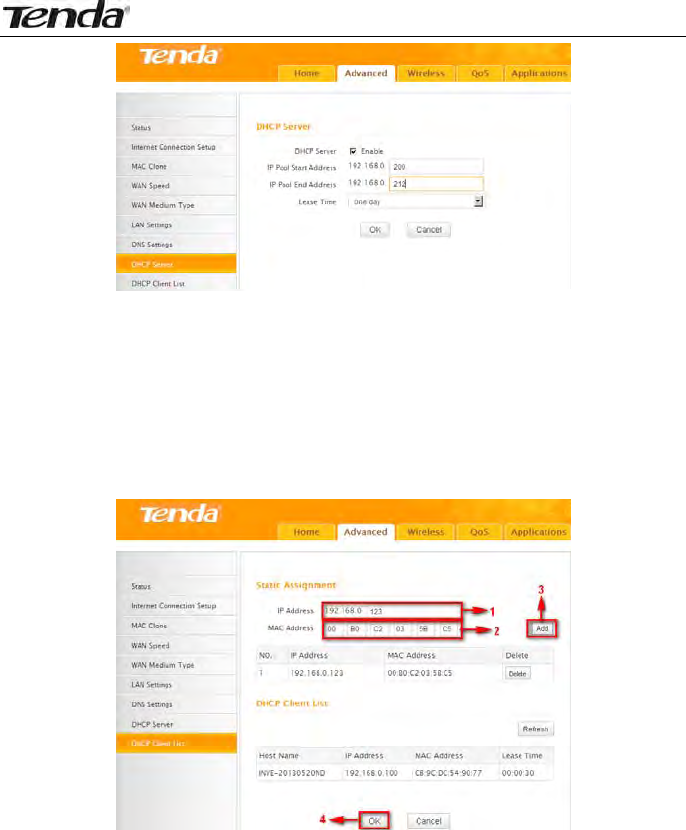
Wireless N300 Easy Setup Router
31
3.9 DHCP Client List
DHCP Client List displays information of devices that have obtained IP
addresses from the device’s DHCP Server. If you would like some devices on
your network to always get the same IP addresses, you can manually add a
static DHCP reservation entry for each such device.
1. IP Address: Enter the IP address for static DHCP reservation.
2. MAC Address: Enter the MAC address of a computer to always receive
the same IP address (the IP you just specified).
3. Add: Click to add the entry to the MAC address reservation list.
4. OK: Click to save your settings.

Wireless N300 Easy Setup Router
32
Note:
If the IP address you have reserved for your PC is currently used by another
client, then you will not be able to obtain a new IP address from the device's
DHCP server, instead, you must manually specify a different IP address for
your PC to access Internet.
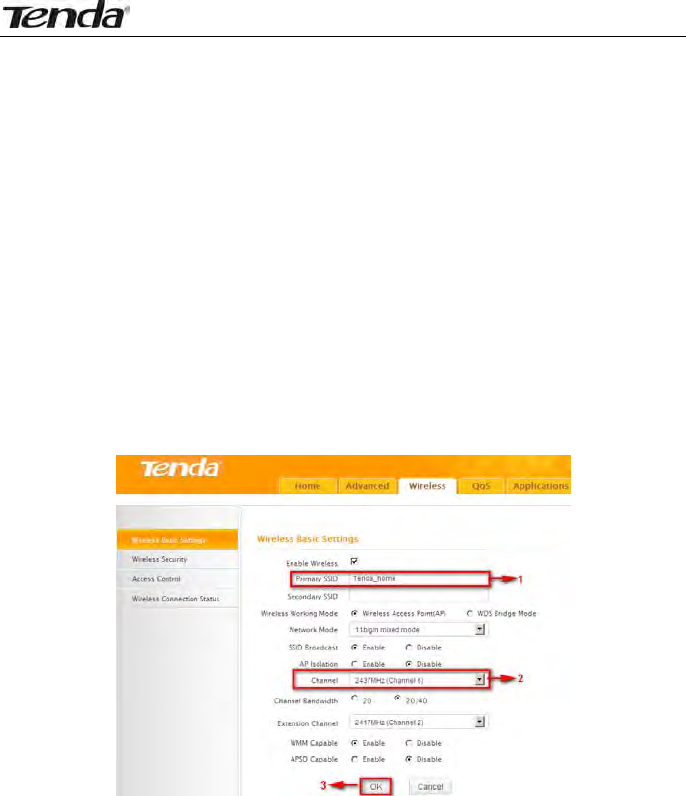
Wireless N300 Easy Setup Router
33
Chapter 4 Wireless Settings
4.1 Wireless Basic Settings
Here you can expand your wireless coverage with the following modes:
Wireless AP (default mode) and WDS.
1. Wireless Access Point (AP): Select this mode if you want to convert
an existing wired network to a wireless network so as to extend Internet
access to wireless clients.
2. WDS Bridge Mode: wireless distribution system (WDS) is a system
enabling the wireless interconnection of access points in an IEEE 802.11
network. It allows a wireless network to be expanded using multiple
access points without the traditional requirement for a wired backbone
to link them. Select this mode if you want to extend an existing wireless
network. The two modes are described as below:
4.1.1 Wireless AP Mode
1. SSID: This is the public name of your wireless network. The default is
Tenda_XXXXXX. XXXXXX is the last six characters in the device's MAC
address. It is recommended that you change it for better security and
identification.
2. Channel: Select a channel that is the least used by neighboring
networks from the drop-down list or Auto. Channels 1, 6 and 11 are
recommended.
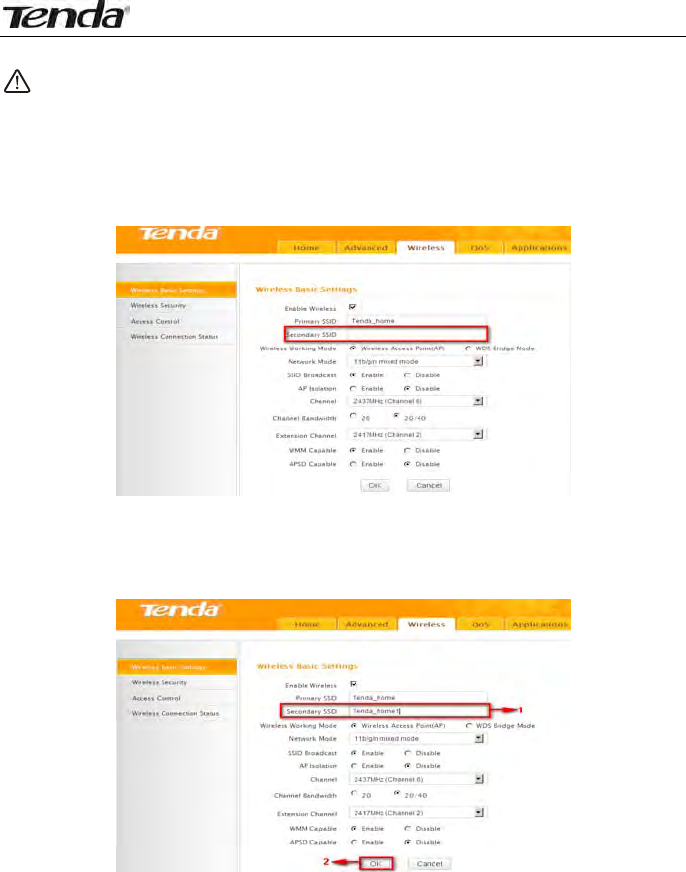
Wireless N300 Easy Setup Router
34
3. OK: Click to save your settings.
Note:
1. It is advisable to keep other items unchanged from factory default
settings. For more details of other features, see Appendix 1.
2. The device supports two SSIDs: primary SSID and secondary SSID. The
secondary SSID is optional, left blank and disabled by default.
3. To enable the secondary SSID, simply specify a SSID in the field and
click OK.
4. Instructions to configure the primary SSID also apply to the secondary
SSID. The primary SSID is used below to illustrate all wireless related
features.
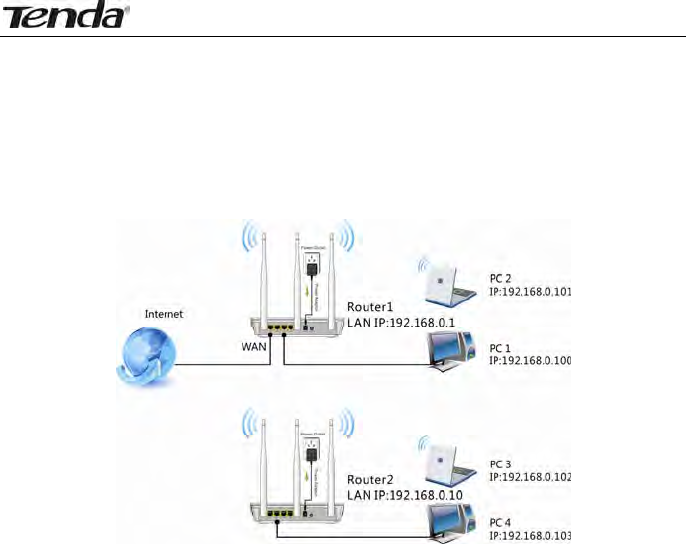
Wireless N300 Easy Setup Router
35
4.1.2 WDS Bridge Mode
WDS Bridge Mode: wireless distribution system (WDS) is a system enabling
the wireless interconnection of access points in an IEEE 802.11 network. It
allows a wireless network to be expanded using multiple access points
without the traditional requirement for a wired backbone to link them. Note:
The Access Points you select MUST support WDS.
For example:
As seen in the figure above, PC1 and PC2 access Internet via a wireless
connection to Router 1. While PC3 and PC4 are too far to directly connect to
Router 1 for Internet access. Now you can use the WDS bridge feature to let
PC3 and PC4 access Internet.
Before you get started:
1. View and note down the wireless security settings: security mode, cipher
type, security key, etc. on Router 1.
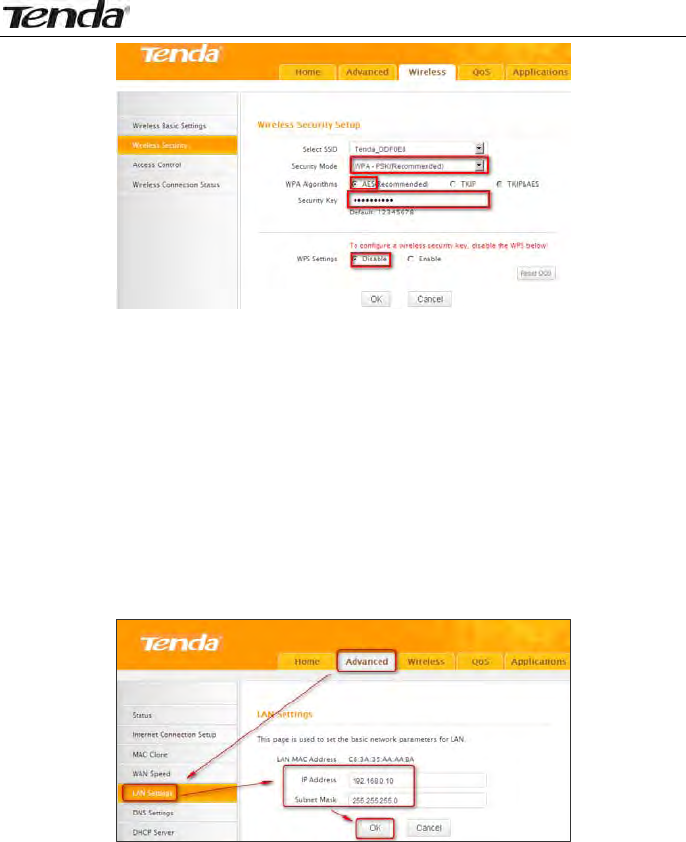
Wireless N300 Easy Setup Router
36
2. Verify that DHCP server is enabled on Router 1.
3. Set the LAN IP address of Router 2 to a different address yet on the same
net segment as Router 1.
As shown below:
Router 1:
LAN IP: 192.168.0.1;
Subnet Mask: 255.255.255.0;
Router 2:
LAN IP:192.168.0.10;
Subnet Mask: 255.255.255.0;
Then do as follows:
1. Configure Router 2:
1) Wireless Working Mode: Select WDS Bridge Mode.
2) Click Open Scan (or Scan) to search for Router 1.
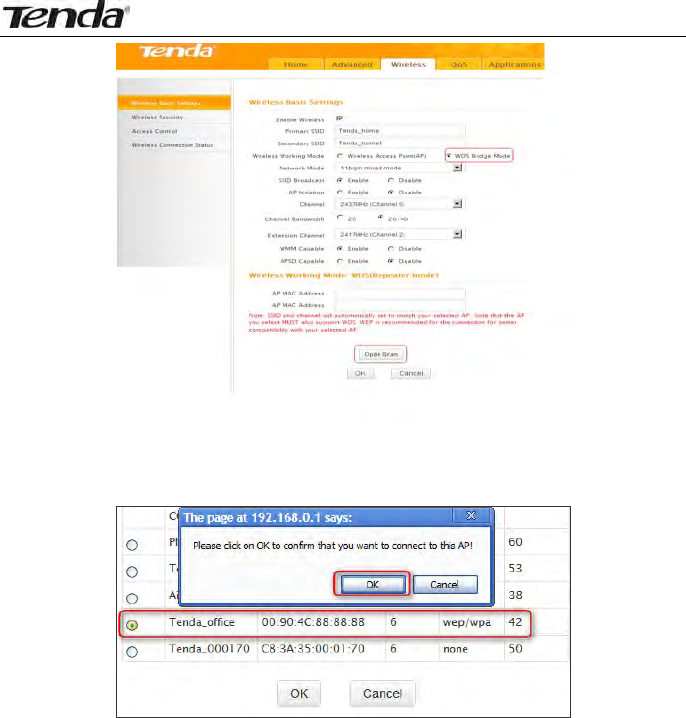
Wireless N300 Easy Setup Router
37
3) Select the wireless network to connect and click OK.
4) Verify that the SSID, channel, and AP MAC address on the page match
those of the added wireless network. If not, manually correct them.
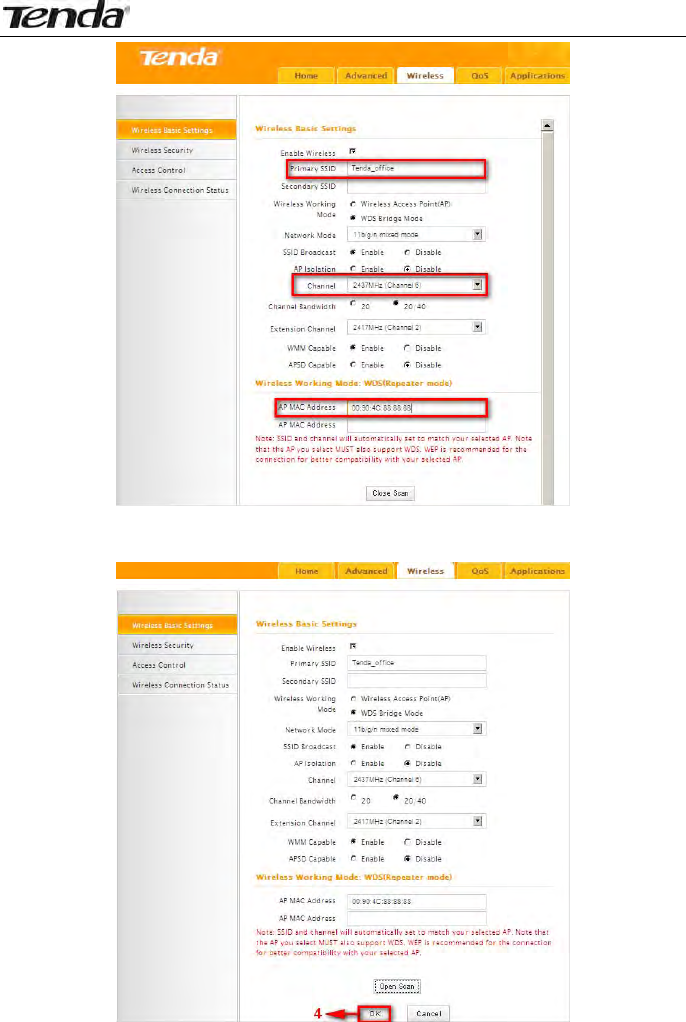
Wireless N300 Easy Setup Router
38
5) Close Scan and click OK to save your settings.
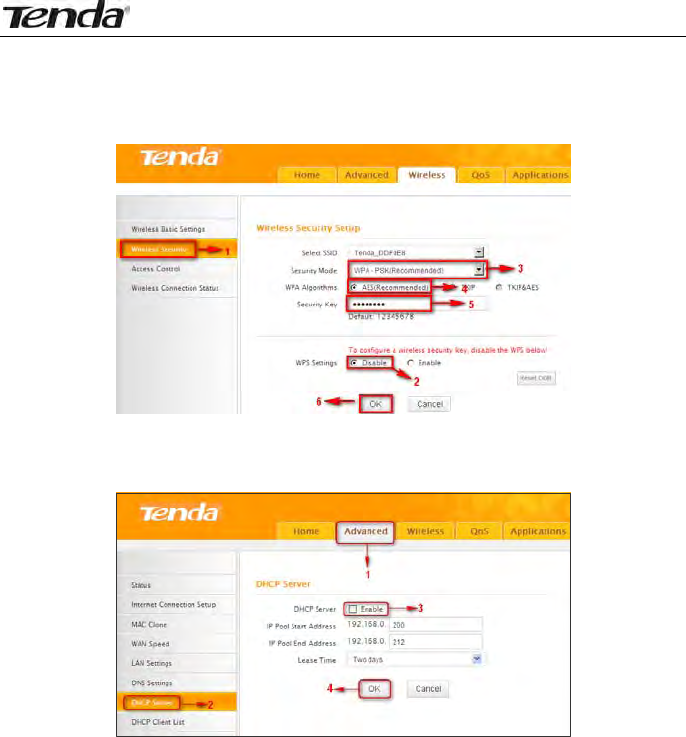
Wireless N300 Easy Setup Router
39
6) Go to Wireless Security page and set the wireless security settings exactly as they
are on the link partner (Router 1).
7) Go to DHCP Server to disable the DHCP on Router 2. Now you have finished all
settings on Router 2 required for WDS.
2. Configure Router 1:
1) Go to wireless section on Router 1 and specify WDS (or WDS Bridge)
as its wireless working mode.
2) Manually enter Router 2's MAC address (Also, you can use the Scan
option as mentioned above) and click OK to finish your settings.
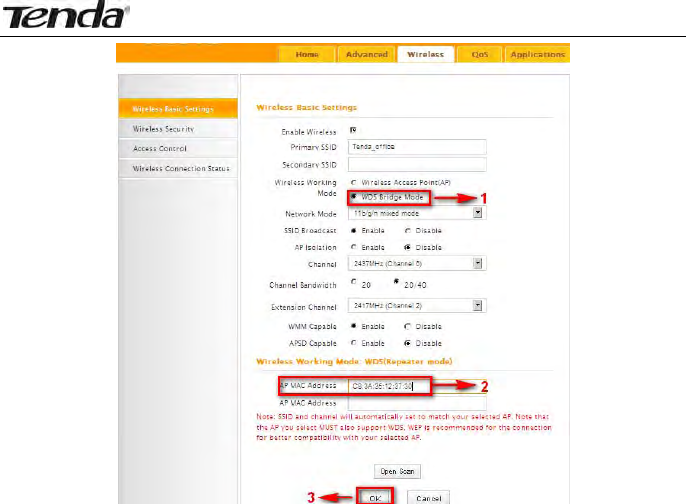
Wireless N300 Easy Setup Router
40
3. Configure PC3 and PC4:
1) Set PC3 and PC4 to Obtain an IP address automatically.
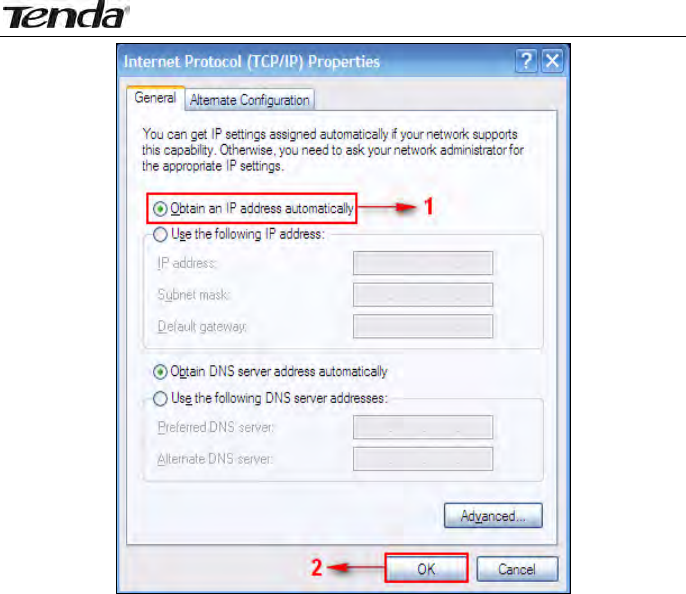
Wireless N300 Easy Setup Router
41
2) When the two PCs get IP addresses,
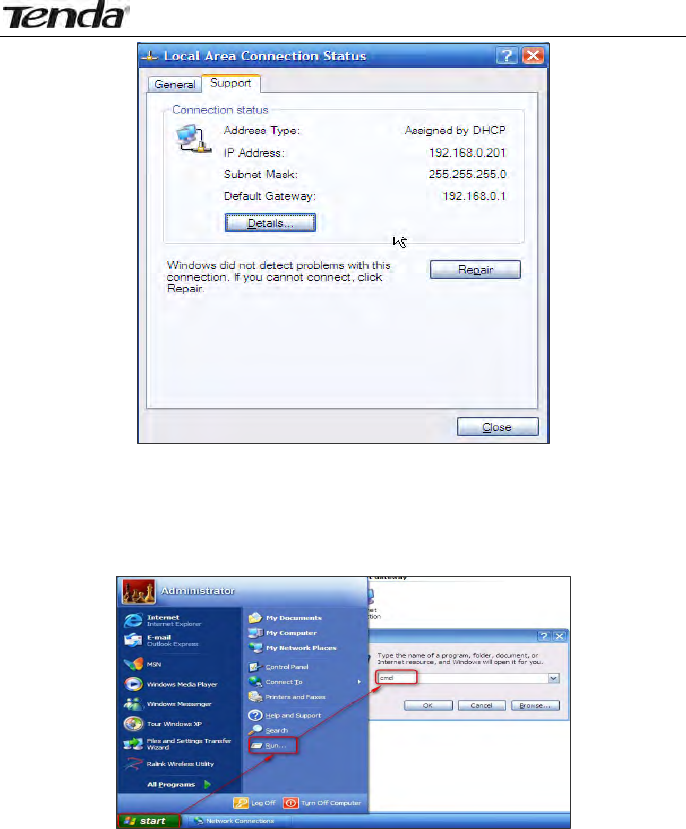
Wireless N300 Easy Setup Router
42
try below steps to verify the WDS connection:
Click Start-> Run on PC3, input cmd on the appearing window and then
click OK.
Input ping 192.168.0.1 and press Enter. If you get a screen as seen below,
you have successfully implemented WDS.
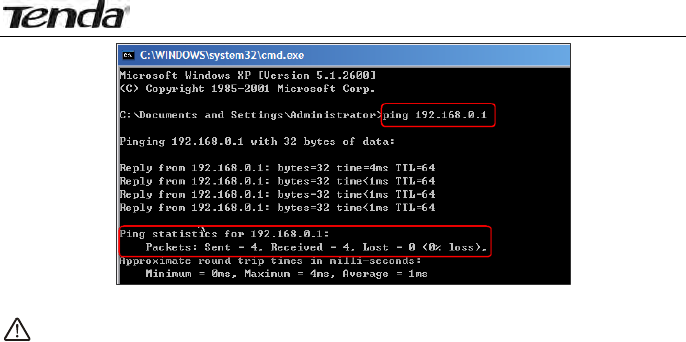
Wireless N300 Easy Setup Router
43
Note:
1. WDS feature can only be implemented between 2 WDS-capable wireless
devices. Plus, SSID, channel, security settings and security key must be
exactly the same on both such devices.
2. To ensure a proper wireless connection, do not change any settings on
the two devices after WDS is successfully implemented.
4.2 Wireless Security
This section allows you to secure your wireless network and block
unauthorized accesses and malicious packet sniffing. To encrypt your
wireless network, do as follows:
1. Select the wireless network (SSID) you wish to encrypt.
2. Disable WPS. (WPS is enabled on the router by default. If you want to
use other security modes, you must first disable the WPS.)
3. Select a proper security mode and cipher type (also known as WPA
Algorithm or WPA Encryption Type). WPA-PSK and AES are
recommended by system default. (5 security modes are available for
your selection. Among them, WPA-PSK outstands with greater
compatibility and security. For more information of other security modes,
see appendix 2) Specify a security key that includes at least 8
characters.
4. Click OK to complete your settings.
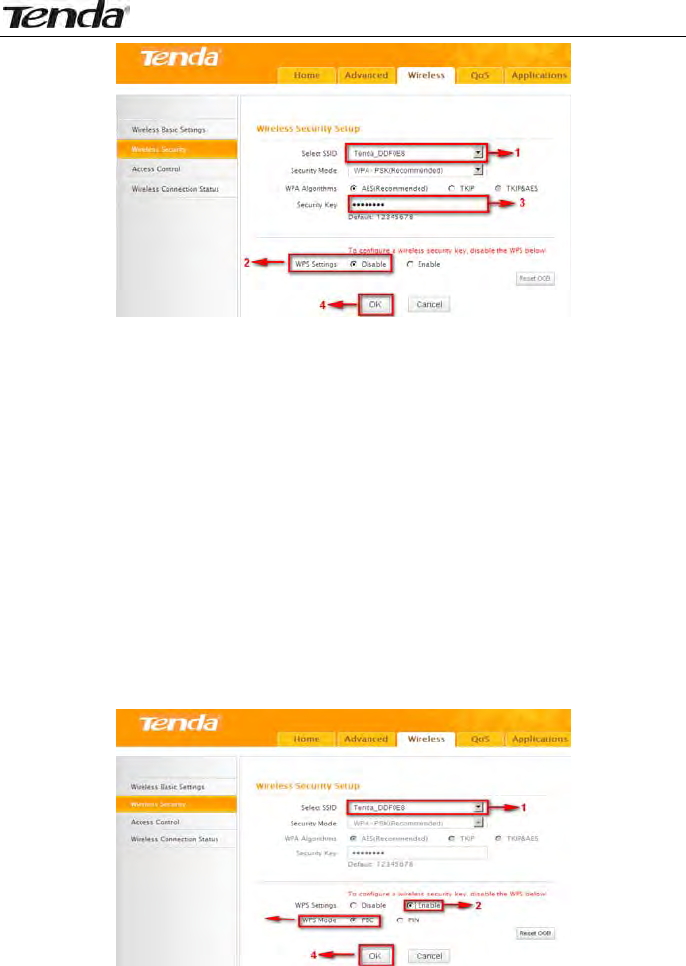
Wireless N300 Easy Setup Router
44
WPS
Wi-Fi Protected Setup makes it easy for home users who know little of
wireless security to establish a home network, as well as to add new devices
to an existing network without entering long passphrases or configuring
complicated settings. Simply enter a PIN code or press the software PBC
button or hardware WPS button (if any) and a secure wireless connection is
established.
Operation Instructions:
PBC: To use WPS-PBC, try two ways below:
1) Press the hardware WPS button on the router for about 1 second and
then enable WPS/PBC on the client device within 2 minutes;
2) Press the hardware WPS button on the router for about 1 second and
then enable WPS/PBC on the client device within 2 minutes;
PIN: On the wireless security page, enable WPS, select PIN and enter the
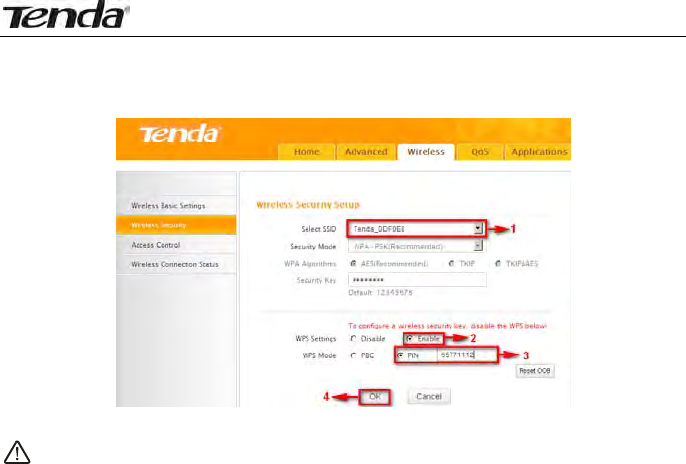
Wireless N300 Easy Setup Router
45
8-digit PIN code from network adapter; then, within 2 minutes, enable
WPS/PIN on the client device;
Note:
1. With WPS successfully enabled, the WPS LED on the router keeps
blinking for about 2 minutes, and during this time, you can enable WPS
on a wireless adapter; if the adapter successfully joins the wireless
network, the WPS LED will display a solid light. Repeat steps above if you
want to add more wireless adapters to the router.
2. Reset OOB: Clicking this button will reset SSID to factory default and
disable security mode.
3. Existing wireless settings will still be maintained by default after a
successful WPS connection. Namely security settings and SSID on the
router will still be the same. If you want to generate a random wireless
key via WPS, click Reset OOB and then follow WPS setup instructions
above.
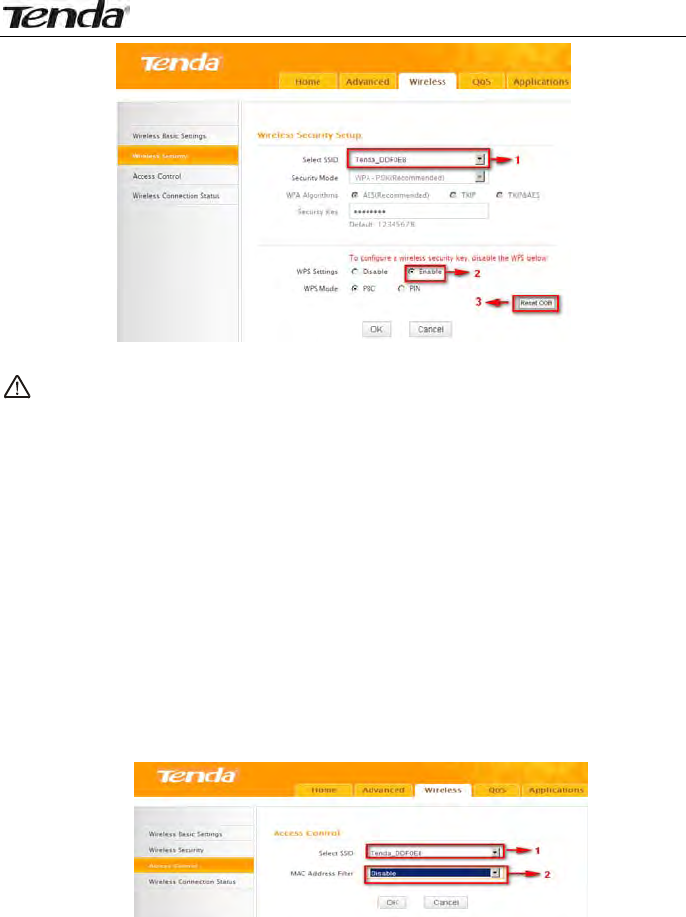
Wireless N300 Easy Setup Router
46
Note:
1. To use the WPS security, the wireless client must be also WPS-capable.
2. Before you press the hardware WPS button on the device for WPS/PBC
connection, making sure the WPS feature has been enabled on the
device.
4.3 Wireless Access Control
The Access Control feature allows you to specify a list of devices to Permit or
Forbid a connection to your wireless network via the devices’ MAC addresses.
All other devices not listed as Permitted will be Forbidden and vice versa.
1. Select the wireless network (SSID) you wish to enable Access Control
on.
2. MAC Address Filter: Select Permit or Forbid from the drop-down list.
3. To permit a wireless device to connect to your wireless network, select
Permit (or Allow), enter its MAC address, click Add and then OK. Then
only this device listed as “Permitted” will be able to connect to your
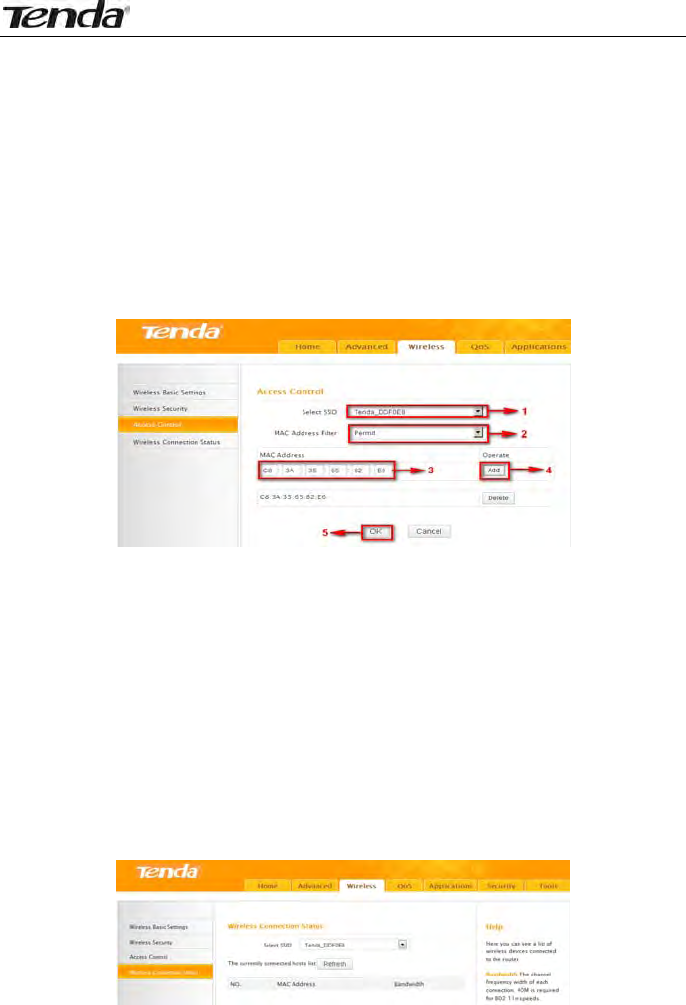
Wireless N300 Easy Setup Router
47
wireless network; all other wireless devices will forbidden.
Step1. Select the wireless network (SSID) you wish to enable Access Control
on.
Step2. Select Permit from the corresponding drop-down menu.
Step3. Enter the MAC address you wish to permit in the MAC address box
and click Add.
Step4. Click OK to save your settings. You can add more wireless MAC
addresses you wish to allow.
Example: To forbid the PC at the MAC address of C8:3A:35:65:82:E6 from
connecting to your wireless network, do as follows:
Step1. Select an SSID, say, Tenda_home.
Step2. Select Forbid (or Deny) from the corresponding drop-down menu.
Step3. Enter C8:3A:35:65:82:E6 in the MAC address box and click Add.
Step4. Click OK to save your settings. You can add more wireless MAC
addresses you wish to forbid.
4.4 Wireless Client
Here you can see a list of wireless devices connected to the router, including
their MAC addresses and bandwidth

Wireless N300 Easy Setup Router
48
Note: The bandwidth here refers to the channel bandwidth instead of
wireless connection rate.
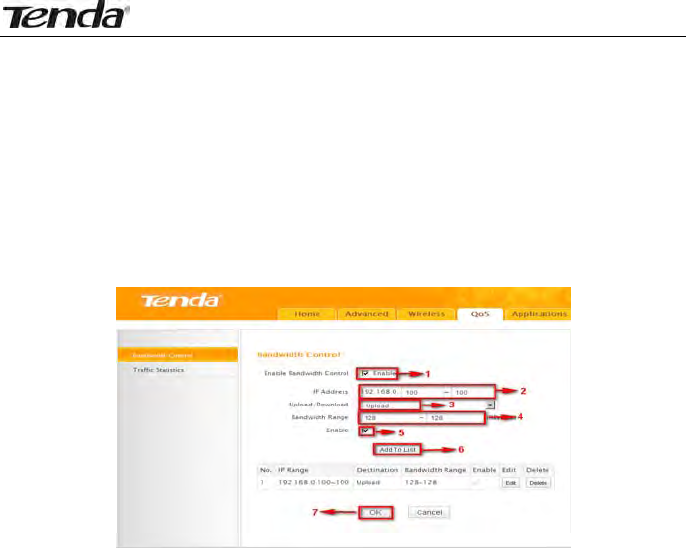
Wireless N300 Easy Setup Router
49
Chapter 5 Bandwidth Control
5.1 Bandwidth Control
Use this section to manage bandwidth allocation to devices on your LAN. If
there are multiple PCs behind your router competing for limited bandwidth
resource, then you can use this feature to specify a reasonable amount of
bandwidth for each such PC, so that no one will be over stuffed or starved to
death.
1. Enable Bandwidth Control: Check or uncheck the box to
2. Enable or disable the bandwidth control feature.
3. IP Address: Specify the same IP address (say, 100, 100) or two
different IP addresses (say, 100, 110) in both boxes to specify a single
IP address or an IP range to which the current bandwidth control rule will
apply.
4. Upload/Download: Select to control bandwidth over data upload or
download.
5. Bandwidth Range: Specify an upload/download bandwidth range
limit on specified PC(s). The unit is KByte/s. 1M=128KByte/s. Note that
maximum upload/download bandwidth should not exceed your router's
WAN bandwidth limit. (Consult your ISP if you are not clear.).
6. Enable: Check to enable current rule. (When disabled, corresponding
entry will not take effect though existing in fact.)
7. Add to List: Click to add current rule to the rule list.
8. OK: Click to activate your settings.
For example:
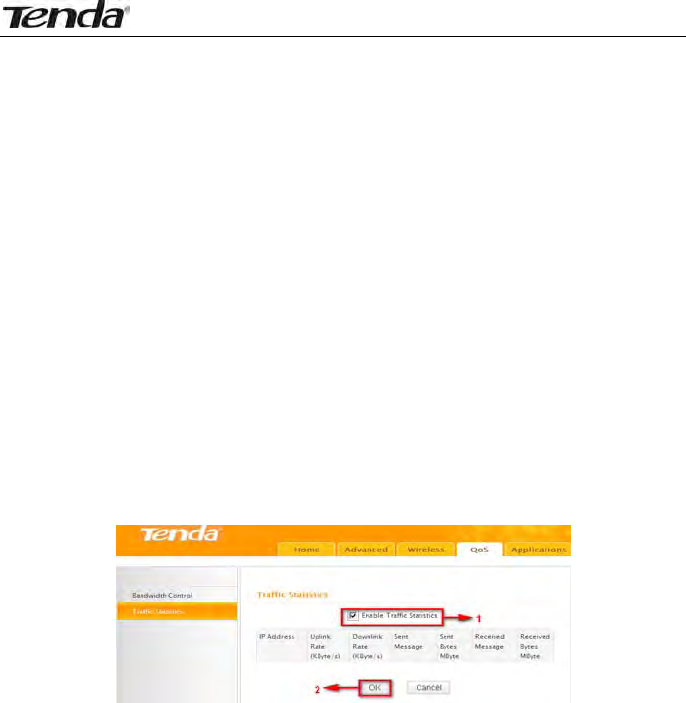
Wireless N300 Easy Setup Router
50
If you are sharing a 4M broadband connection with a neighbor, who always
exhausts the bandwidth resource downloading data, this feature will help.
Simply specify half of the 4M bandwidth for your neighbor's PC (say,
192.168.0.100) and you will no longer need to struggle for bandwidth and
your neighbor will only get up to 2M bandwidth. To do so, follow instructions
below:
1
1.
. C
Ch
he
ec
ck
k
E
En
na
ab
bl
le
e.
.
2
2. Input "192.168.0.100" in both IP address boxes.
3
3.
.
Select Download.
4
4.
.
Enter "256" in both bandwidth range fields.
5
5.
.
Check Enable.
6
6.
.
Click Add To List
7
7.
.
Click OK.
5.2 Traffic Statistics
Traffic Statistics allows you to see at a glance how much traffic each device
in your network is using.
Enable Traffic Statistics: Check/uncheck the box to enable/disable the
Traffic Statistics feature. To see at a glance how much traffic each device in
your network is using, enable this option. However usually, disabling it may
boost your network performance. This option is disabled by default. However,
once enabled the page refreshes every five minutes.
OK: Click to activate corresponding settings.
IP Address: Displays IP addresses of PCs connected to the device.
Uplink Rate: Displays the upload speed (KByte/s) of a corresponding PC.
Downlink Rate: Displays the download speed (KByte/s) of a corresponding
PC.
Sent Message: Displays the number of packets sent by a corresponding PC
via the device since Statistics is enabled.
Sent Bytes: Displays the number of Bytes sent by a corresponding PC via

Wireless N300 Easy Setup Router
51
the device since Statistics is enabled. The unit is MByte.
Received Message: Displays the number of packets received by a
corresponding PC via the device since Statistics is enabled.
Received Bytes: Displays the number of Bytes received by a corresponding
PC via the device since Statistics is enabled. The unit is MByte.
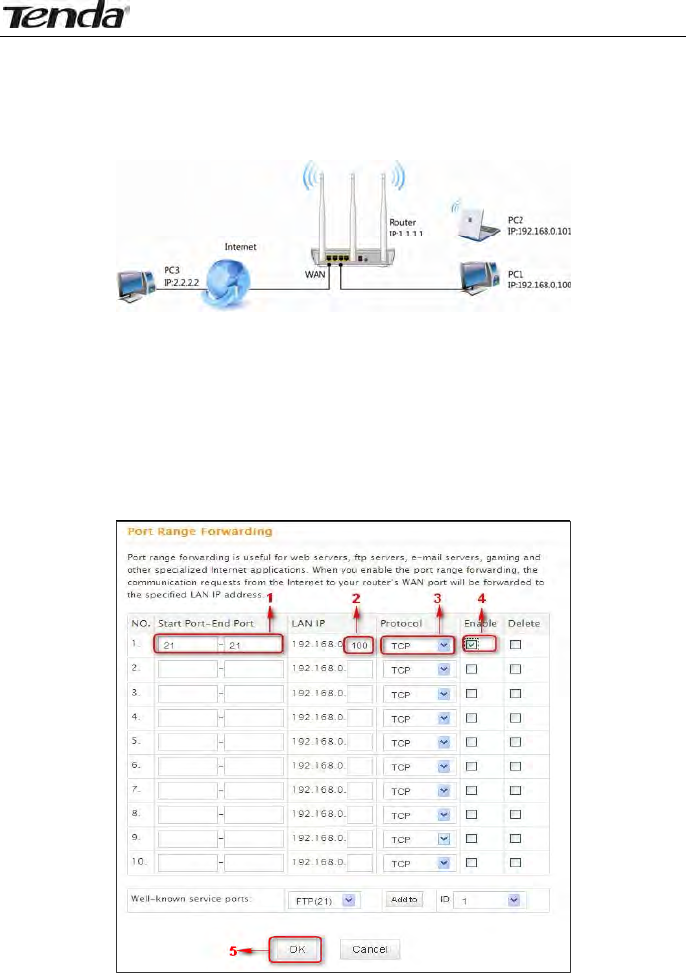
Wireless N300 Easy Setup Router
52
Chapter 6 Special Applications
6.1 Port Range Forwarding
Port range forwarding is useful for web servers, ftp servers, e-mail servers,
gaming and other specialized Internet applications. When you enable port
forwarding, the communication requests from the Internet to your router’s
WAN port will be forwarded to the specified LAN IP address. As seen in the
figure above, to let PC3 access service ports on PC1, you must first configure
port forwarding settings on the router to which PC1 is uplinked.
1. Start/End Port: Specify a range of ports between 1~65535 (for a
single port, enter the port number in both Start and End fields, say, 21

Wireless N300 Easy Setup Router
53
for FTP). Contact corresponding service provider if you don't know the
port number of the service to use.
2. LAN IP: Specify the internal host’s IP address. Be sure to statically
assign the host’s IP address to make this function constant.
3. Protocol: Specify the protocol required for the service utilizing the
port(s).
4. Enable: Check to enable current settings.
5. OK: Click to activate your settings.
Now, your friends only need to enter ftp://xxx.xxx.xxx.xxx:21 in their
browsers to access your FTP server xxx.xxx.xxx.xxx is the router's WAN IP
address. Assuming it is 172.16.102.89, and then your friends need to enter
ftp://172.16.102.89:21 in their browsers.
For example:
You want to share some large files with your friends who are not in your LAN;
however it is not convenient to transfer such large files across network. Then,
you can set up your own PC as a FTP server and use the Port (Range)
Forwarding feature to let your friends access these files. Assuming that the
static IP address of the FTP server (Namely, your PC) is 192.168.0.10, you
want your friends to access this FTP server through default port of 21 using
the TCP protocol, then do as follows:
1. Start/End Port: Enter 21 in both Start Port and End Port fields.
2. LAN IP: Enter 192.168.0.10
3. Protocol: Select TCP.
4. Enable: Check to enable current settings.
5. OK: Click to activate your settings.
Note: If you include port 80 on this section, you must set the port for
remote (web-based) management to a different number than 80, such
as 8080, otherwise the virtual server feature may not take effect.
6.2 DMZ Host
The DMZ (De-Militarized Zone) function disables the firewall on the router
for one device for a special purpose service such as Internet gaming or video
conferencing. Enabling DMZ host may expose your local network to potential
attacks. So it is advisable to use it with caution.
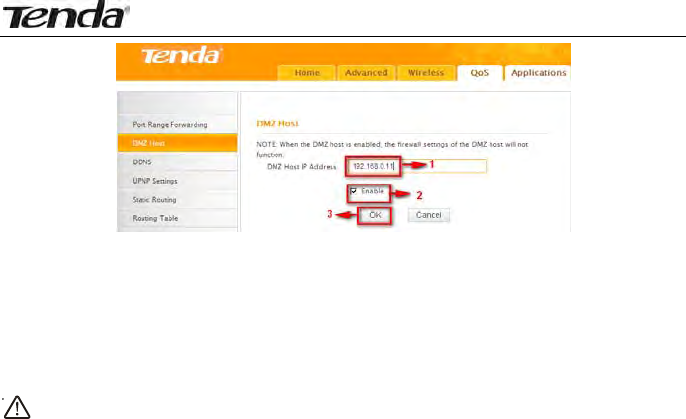
Wireless N300 Easy Setup Router
54
1. DMZ Host IP Address: The IP Address of the device for which the
router’s firewall will be disabled. Be sure to statically set the IP Address
of that device for this function to be consistent.
2. Enable: Check/uncheck to enable/disable the DMZ host feature.
3. OK: Click to enable your settings.
Note:
Once enabled, the DMZ host loses protection from device's firewall and
becomes vulnerable to attacks.
6.3 DDNS
Dynamic DNS or DDNS is a term used for the updating in real time of
Internet Domain Name System (DNS) name servers. Dynamic DNS or DDNS
is a term used for the updating in real time of Internet Domain Name System
(DNS) name servers. We use a numeric IP address allocated by Internet
Service Provider (ISP) to connect to Internet; the address may either be
stable ("static"), or may change from one session on the Internet to the next
("dynamic"). However, a numeric address is inconvenient to remember; an
address which changes unpredictably makes connection impossible. The
DDNS provider allocates a static host name to the user; whenever the user
is allocated a new IP address this is communicated to the DDNS provider by
software running on a computer or network device at that address; the
provider distributes the association between the host name and the address
to the Internet's DNS servers so that they may resolve DNS queries. Thus,
uninterrupted access to devices and services whose numeric IP address may
change is maintained. (You need to have an account with one of the Service
Providers in the drop-down menu first.)
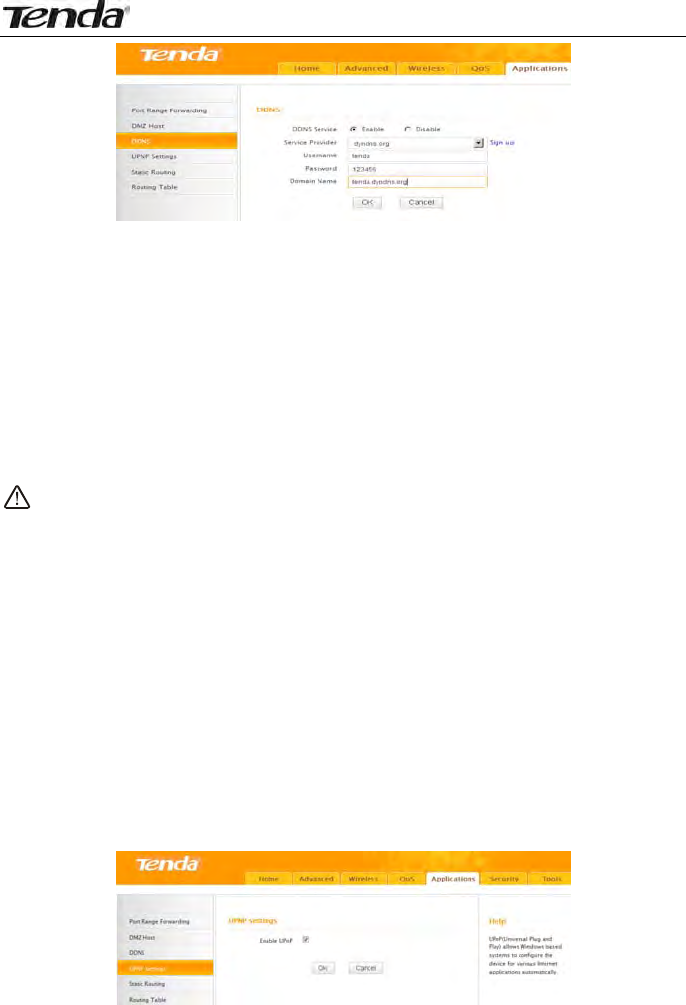
Wireless N300 Easy Setup Router
55
1. DDNS Service: Select to enable/disable the DDNS feature.
2. Service Provider: Select your DDNS service provider from the
drop-down menu. (Here you can see a list of available service providers.
Note that service providers not listed here are not available for use.)
3. User Name: Enter the registered user name.
4. Password: Enter the registered password.
5. Domain Name: Enter the domain name you register, say,
tenda.dyndns.org.
6. OK: Click to activate your settings.
Note:
This feature is usually used together with virtual server. Configure necessary
settings on port forwarding interface and enter the information provided by
your DDNS service provider on the DDNS screen. Others can access your
web server by simply entering http://tenda.dyndns.org in their browser
address bar.
6.4 UPNP
The Universal Plug and Play (UPnP) feature allows network devices, such as
computers from Internet, to access resources on local host or devices as
needed. UPnP-enabled devices can be discovered automatically by the UPnP
service application on the LAN. This feature is enabled by default. No
settings are required.
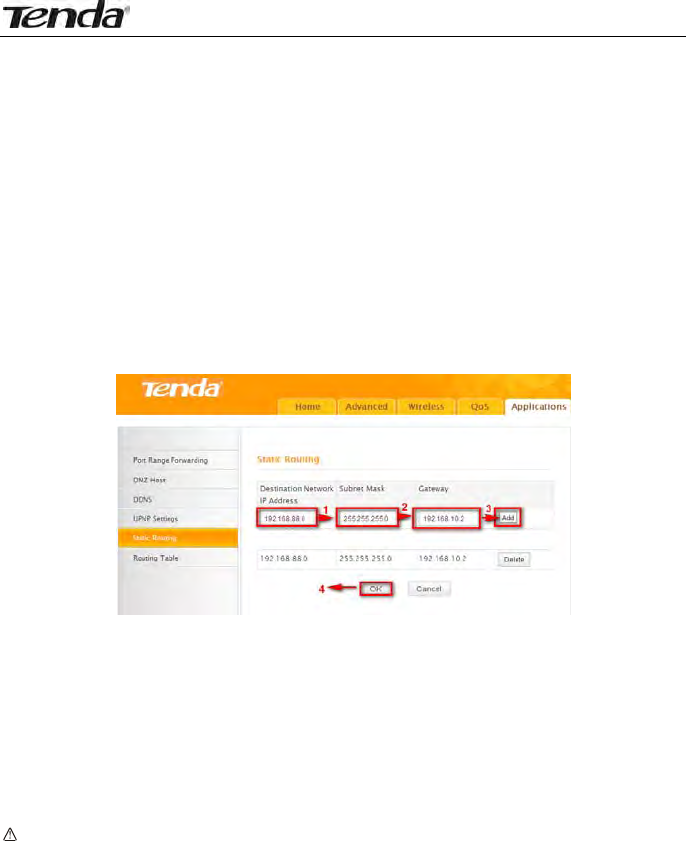
Wireless N300 Easy Setup Router
56
Enable UPnP: Check/uncheck to enable/disable the UPnP feature.
OK: Click to complete your settings.
6.5 Static Routing
When there are several routers in the network, you may want to set up static
routing. Static routing determines the path of the data in your network. You
can use this feature to allow users on different IP domains to access the
Internet via this device. It is not recommended to use this setting unless you
are familiar with static routing. In most cases, dynamic routing is
recommended, because this feature allows the router to detect the physical
changes of the network layout automatically. If you want to use static
routing, make sure the router’s DHCP function is disabled.
1. Destination Network IP Address: Specify a single IP address, say,
172.17.0.100, or an IP net segment, .say, 192.168.88.0.
2. Subnet Mask: Specify a Subnet Mask that corresponds to the specified
destination IP.
3. Gateway: Specify the IP address for next hop.
4. OK: Click to activate your settings.
Note:
1. Gateway must be on the same IP net segment as device's LAN/WAN IP
address.
2. Subnet Mask must be entered 255.255.255.255 if destination IP address
is a host.
3. Subnet Mask must be entered accordingly if destination IP address
represents an IP network segment. It must correspond to the specified
IP address. For example, for IP address of 10.0.0.0, you may enter a
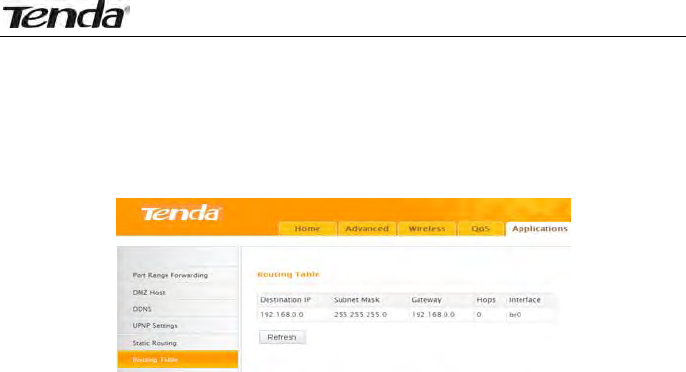
Wireless N300 Easy Setup Router
57
subnet mask of 255.0.0.0.
6.6 Routing Table
This page displays the device core routing table which lists destination IP,
subnet mask, gateway, hop count and interface.
The principal task for a router is to look for an optimal transfer path for each
data packet passing through it, and transfer it to the specified destination.
To complete this work, the router stores and maintains related data of
various transfer paths, i.e. establishing a routing table, for future route
selection.
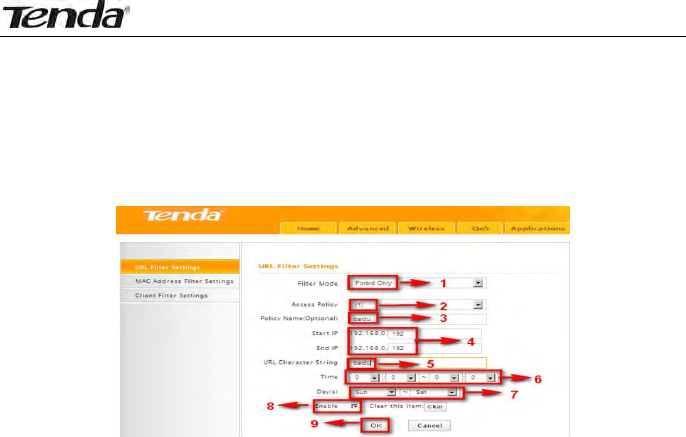
Wireless N300 Easy Setup Router
58
Chapter 7 Security
7.1 URL Filter
To better control LAN PCs, you can use the URL filter functionality to allow or
disallow such PCs to access certain websites within a specified time range.
1. Filter Mode: Select a proper filter mode, say, Forbid Only (or
Forbid/Deny).
2. Access Policy: Select an access policy number, say, 1, from the
drop-down list.
3. Policy Name: Briefly describe the current rule, say, youtube, (It can
only consist of numbers, letters, or underscore).
4. Start IP/End IP: Enter the same IP address or 2 different IP addresses
in both boxes to specify a single PC or a range of PCs for the current rule
to apply to.
5. URL Character String: Enter the domain name you wish to filter out,
say, youtube.
6. Time: Specify a time period for a current rule to take effect. If the field
is set to 0:00-0:00, the rule will be applied 24hrs/day.
7. Day(s): Select a day or several days for a current rule to take effect. If
Sun-Sat is selected, the rule will apply 7days/week.
8. Enable: Check/uncheck to enable/disable the feature.
9. OK: Click to activate your settings.
Example:
If you want to disallow all computers on your LAN to access youtube.com
from 8:00 to 18:00 during working days: Monday- Friday, then do as
follows:
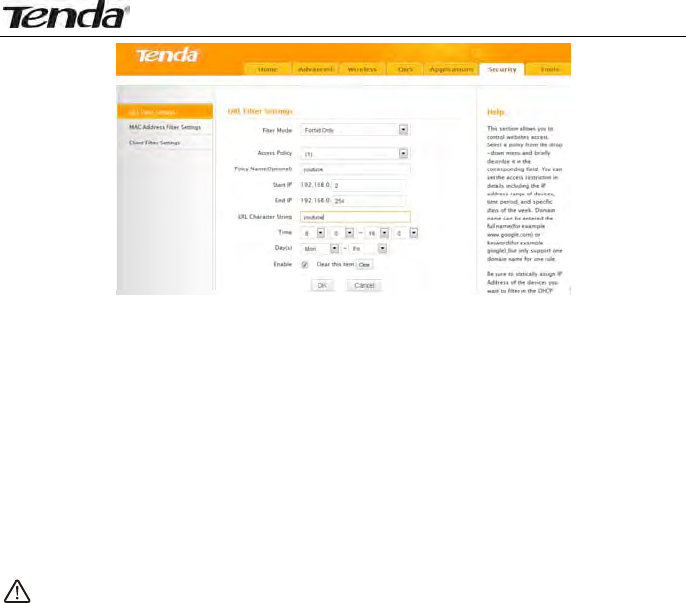
Wireless N300 Easy Setup Router
59
1. Filter Mode: Select Forbid Only.
2. Access Policy: Select an access policy number, say, 1, from the
drop-down list.
3. Policy Name: Briefly describe the current rule, say, youtube, (It can only
consist of numbers, letters, or underscore).
4. Start IP/End IP: Enter 2-254.
5. URL Character String: Enter youtube.
6. Time: Select 8:00-18:00.Day(s): Select Monday to Friday.
7. Enable: Check the Enable box.
8. OK: Click to save your settings.
Note:
Each rule can only include one domain name. Simply add more rules
accordingly, if you want to filter multiple domain names.
7.2 MAC Filter
This section allows you to set the times specific clients can or cannot access
the Internet via the devices’ MAC Addresses.
Forbid Only: Specify a list of devices to Forbid access to Internet. All other
devices not listed as Forbidden will be permitted.
Permit Only: Specify a list of devices to Permit access to Internet. All other
devices not listed as Permitted will be forbidden.
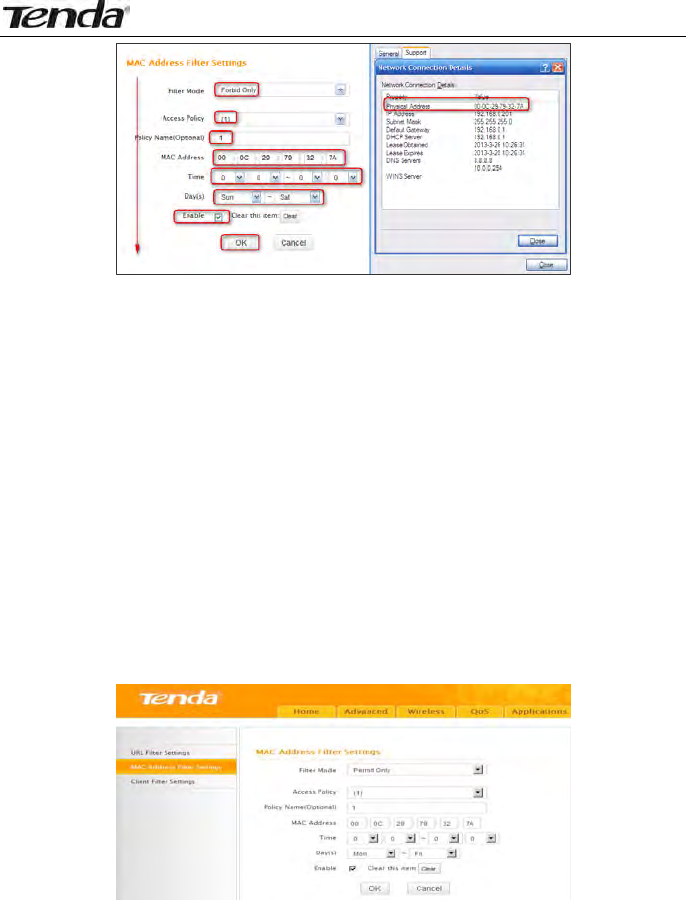
Wireless N300 Easy Setup Router
60
1. Filter Mode: Select a proper filter mode, say, Forbid Only (or
Forbid/Deny).
2. Access Policy: Select an access policy number, say, 1, from the
drop-down list.
3. Policy Name: Briefly describe the current rule (It can only consist of
numbers, letters, or underscore).
4. MAC Address: Specify a MAC address for a corresponding MAC filter
rule to apply to.
5. Time: Specify a time period for a current rule to take effect. If the field
is set to 0:00-0:00, the rule will be applied 24hrs/day.
6. Day(s): Select a day or several days for a current rule to take effect. If
Sun-Sat is selected, the rule will apply 7days/week.
7. Enable: Check/uncheck to enable/disable the feature.
8. OK: Click to activate your settings.
For Example:
To allow a PC at the MAC address of 00:E4:A5:44:35:69 to access Internet
from Monday to Friday.
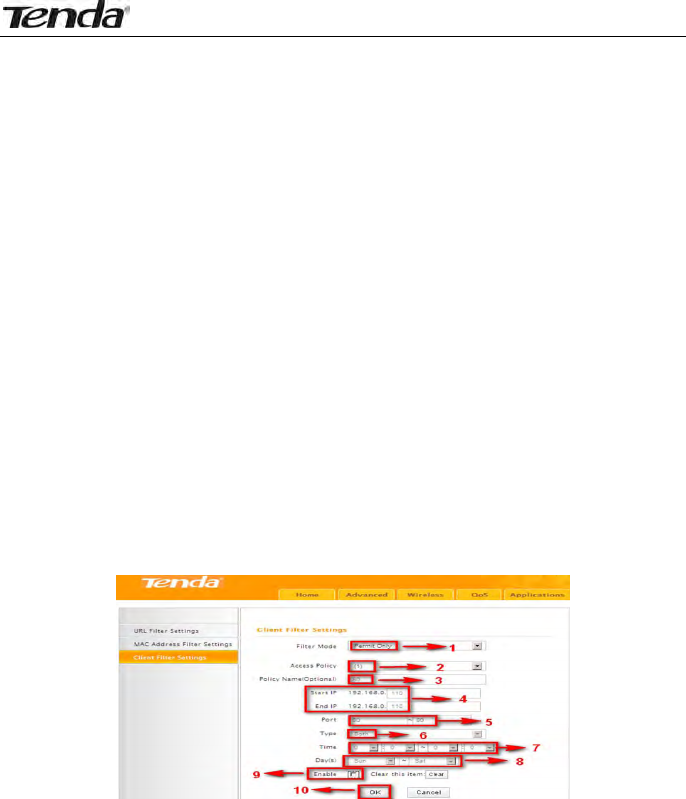
Wireless N300 Easy Setup Router
61
1. Filter Mode: Select Permit Only.
2. Access Policy: Select an access policy number, say, 1, from the
drop-down list.
3. Policy Name: Briefly describe the current rule, say, Permit only, (It
can only consist of numbers, letters, or underscore).
4. MAC Address: Enter 00:E4:A5:44:35:69.
5. Time: Select 0 for all fields to apply the rule 24hrs/day.
6. Day(s): Select Monday to Friday.
7. Enable: Check the Enable box.
8. OK: Click to save your settings.
7.3 Client Filter
This section allows you to set the times specific clients can or cannot access
the Internet via the devices’ assigned IP addresses and service port.
Forbid Only (or Deny/Forbid): Only PCs listed as Forbidden (or Denied)
will be forbidden from accessing specified services; others are not restricted;
Permit Only (or Permit/Allow): Only PCs listed as permitted (or allowed)
will be permitted to access specified services; others will be forbidden.
1. Filter Mode: Select Permit Only.
2. Access Policy: Select an access policy number, say, 1, from the
drop-down list.
3. Policy Name: Briefly describe the current rule, say, 80.
4. Start IP/End IP: Enter the same IP address, say, 110, or 2 different IP
addresses, say, 110 and 120 in both boxes to specify a single PC or a
range of PCs for the current rule to apply to.
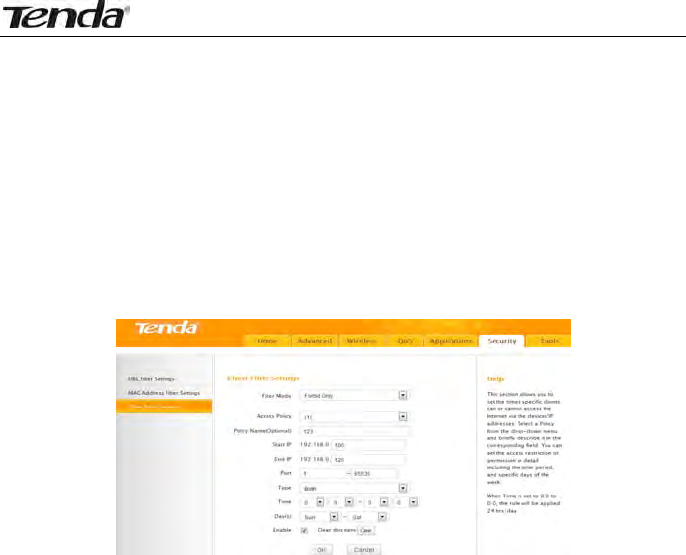
Wireless N300 Easy Setup Router
62
5. Port: Specify TCP/UDP protocol port number (s), say, 80.
6. Type (or Protocol): Select Both.
7. Time: Specify a time period for a current rule to take effect. If the field is
set to 0:00-0:00, the rule will be applied 24hrs/day.
8. Day(s): Specify a day or several days for a current rule to take effect.
9. Enable: Check/uncheck to enable/disable the feature.
10. OK: Click to activate your settings.
For example:
If you want to prohibit PCs within the IP address range of
192.168.0.100--192.168.0.120 from accessing Internet, do as follows:
1. Filter Mode: Select Forbid Only.
2. Access Policy: Select an access policy number, say, 1, from the
drop-down list.
3. Policy Name: Briefly describe the current rule, say, 123.
4. Start IP: Enter 100.
5. End IP: Enter 120.
6. Port: Enter 1-65535 to forbid all Internet services and applications.
7. Type (or Protocol): Select Both.
8. Time: Select 0 for all fields to apply the rule 24hrs/day.
9. Day(s): Select Sun-Sat to apply the rule 7days/week.
10. Enable: Check the Enable box.
11. OK: Click to activate your settings.
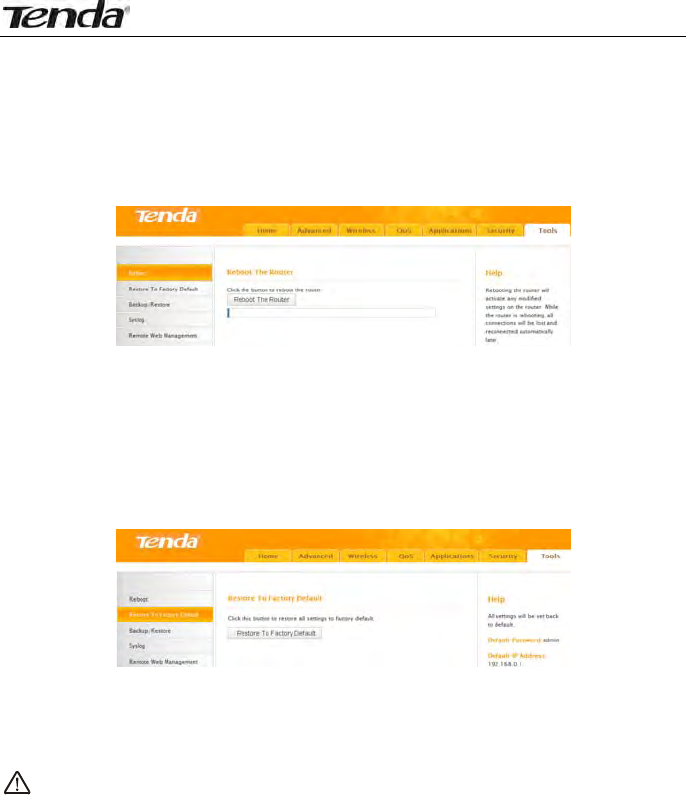
Wireless N300 Easy Setup Router
63
Chapter 8 Tools
8.1 Reboot
Reboot the device to activate your settings. WAN connection will be
disconnected during reboot.
8.2. Restore to Factory Default Settings
Click the Restore to Factory Default button to reset device to factory
default settings. You need to reconfigure the device for Internet access as
well as many other settings including wireless settings.
The factory default settings are listed below:
IP Address: 192.168.0.1
Subnet mask: 255.255.255.0.
Note:
To activate your settings, you need to reboot the device after you reset it.
8.3 Back/Restore
Backup: Once you have configured the device the way you want it, you can
save these settings to a configuration file on your local hard drive that can
later be imported to your device in case that the device is restored to factory
default settings. To do so, follow below instructions:
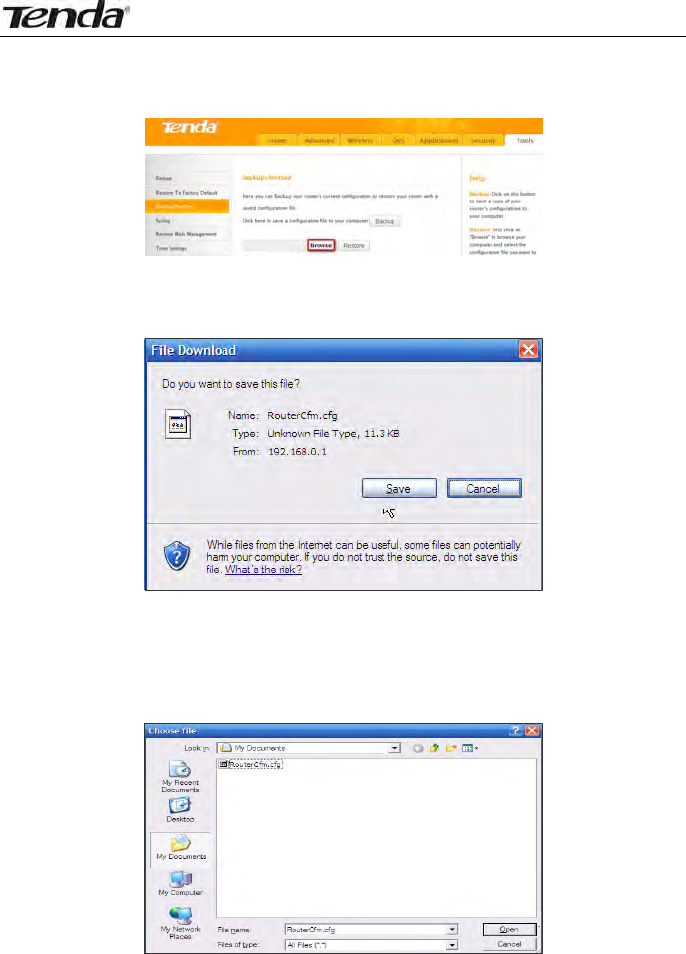
Wireless N300 Easy Setup Router
64
1. Click the Backup button and specify a directory to save settings on your
local hardware.
2. Click Save to save the configuration file.
To restore previous settings, do as follows:
Click the Browse button to locate and select a configuration file that is
saved previously to your local hard drive.
Click the Restore button to reset your device to previous settings.
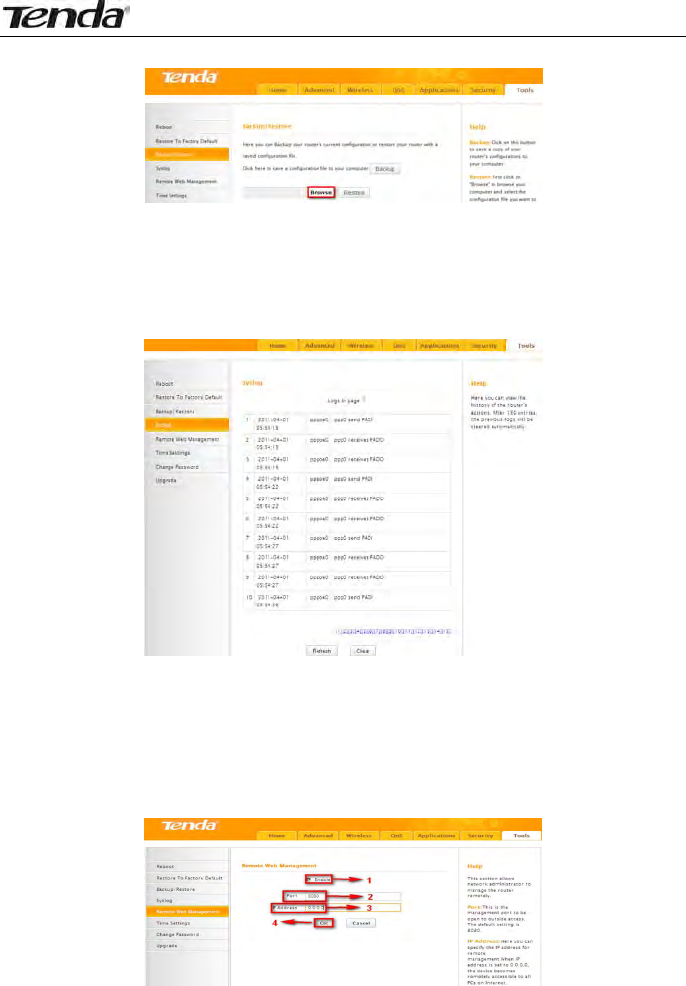
Wireless N300 Easy Setup Router
65
8.4 Syslog
Here you can view the history of the device’s actions. After 150 entries, the
earliest logs will clear automatically.
8.5 Remote Web-based Management
The Remote management allows the device to be configured and managed
remotely from the Internet via a web browser.
1. Enable: Check/uncheck to enable/disable the DMZ host feature.
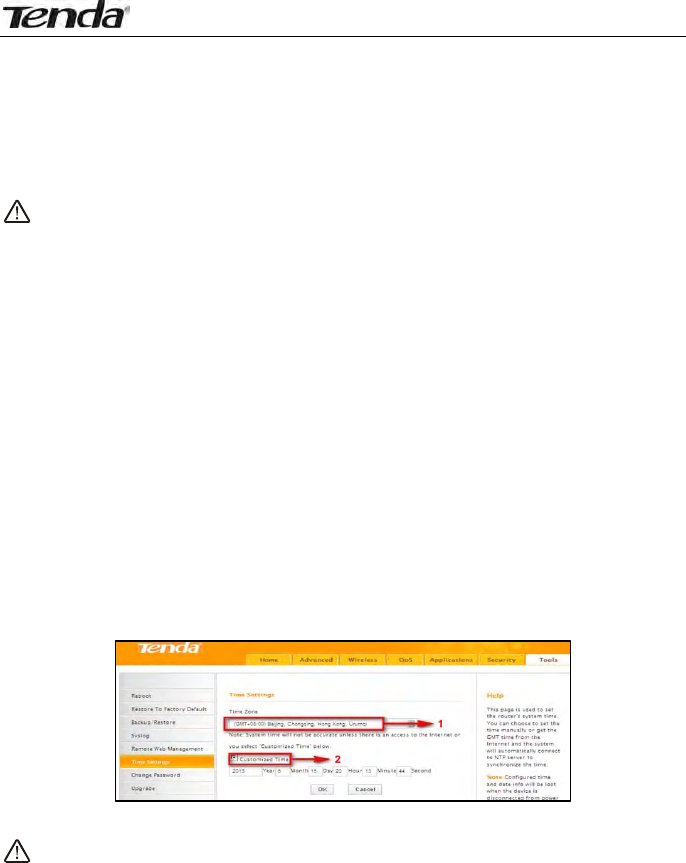
Wireless N300 Easy Setup Router
66
2. Port: This is the management port to be open to outside access. The
default setting is 8080. Do NOT change it unless instructed by your ISP.
3. IP Address: Here you can specify the IP Address Range for remote
management (When set to 0.0.0.0, the device becomes remotely
accessible to all the PCs on Internet or other external networks).
4. OK: Click to activate your settings.
Note:
1. To access the device via port 8080, enter "http://x.x.x.x:8080" where
"x.x.x.x" represents the the device's Internet IP address and 8080 is the
remote admin port. Assuming the device's Internet IP address is
220.135.211.56, then, simply replace the "x.x.x.x" with
"220.135.211.56" (namely, http://220.135.211.56:8080).
2. Leaving the IP address field at "0.0.0.0" makes the device remotely
accessible to all the PCs on Internet or other external networks;
populating it with a specific IP address, say, 218.88.93.33, makes the
device only remotely accessible to the PC at the specified IP address.
8.6 Time
This page is used to set the router’s system time. You can choose to set the
time manually or get the GMT time from the Internet and the system will
automatically connect to NTP server to synchronize the time.
Note:
Configured time and date info will be lost when the device gets disconnected
from power supply. However, it will be updated automatically when the
device reconnects to Internet. To activate time-based features (e.g. firewall),
the time and date info shall be set correctly first, either manually or
automatically.
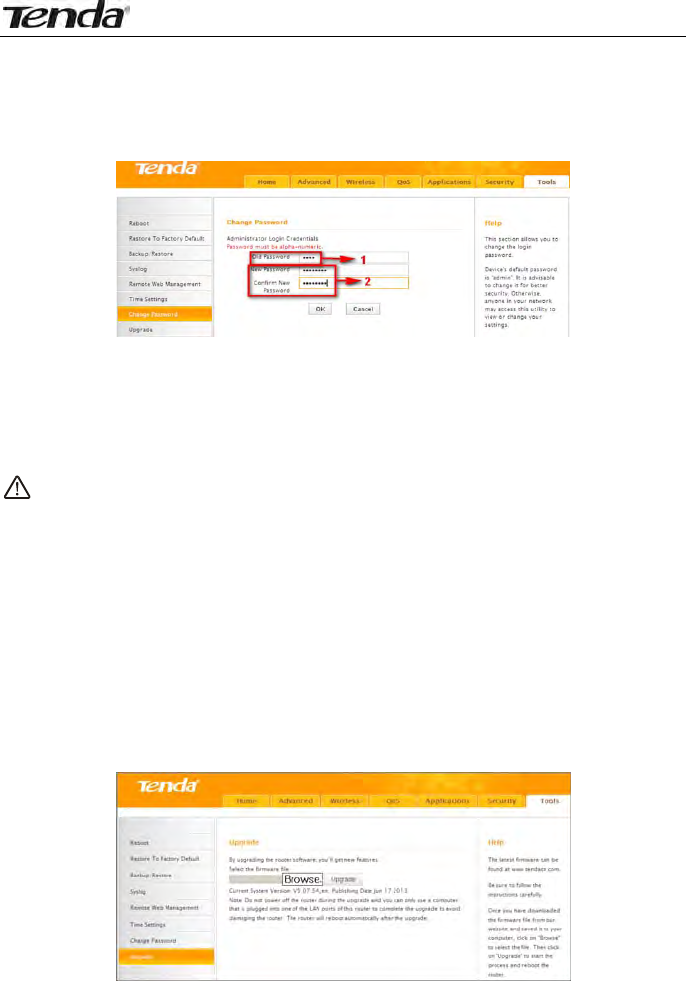
Wireless N300 Easy Setup Router
67
8.7 Login Password
This section allows you to change login password for accessing device’s
Web-based interface for better security.
1. New Password: Enter a new password, say, 12345 (Note that the
password can only be alphanumeric).
2. Confirm New Password: Re-enter the new password for confirmation.
3. OK: Click to activate your settings.
Note:
For security purpose, it is highly recommended that you change Device's
default login password.
8.8 Firmware Upgrade
Firmware upgrade is released periodically to improve the functionality of
your device and also to add new features. If you run into a problem with a
specific feature of the device, log on to our website (www.tendacn.com) to
download the latest firmware to update your device.

Wireless N300 Easy Setup Router
68
1. Browse: Click to locate and select the firmware.
2. Upgrade (or Update): Click to update firmware. Device will restart
automatically when update completes.
Note:
1. Before you upgrade the firmware, making sure you are having a correct
firmware. A wrong firmware may damage the device.
2. Do NOT upgrade the firmware wirelessly or disconnect device from
power supply while firmware update is in process. Note that you need to
update the device's firmware via a wired connection.
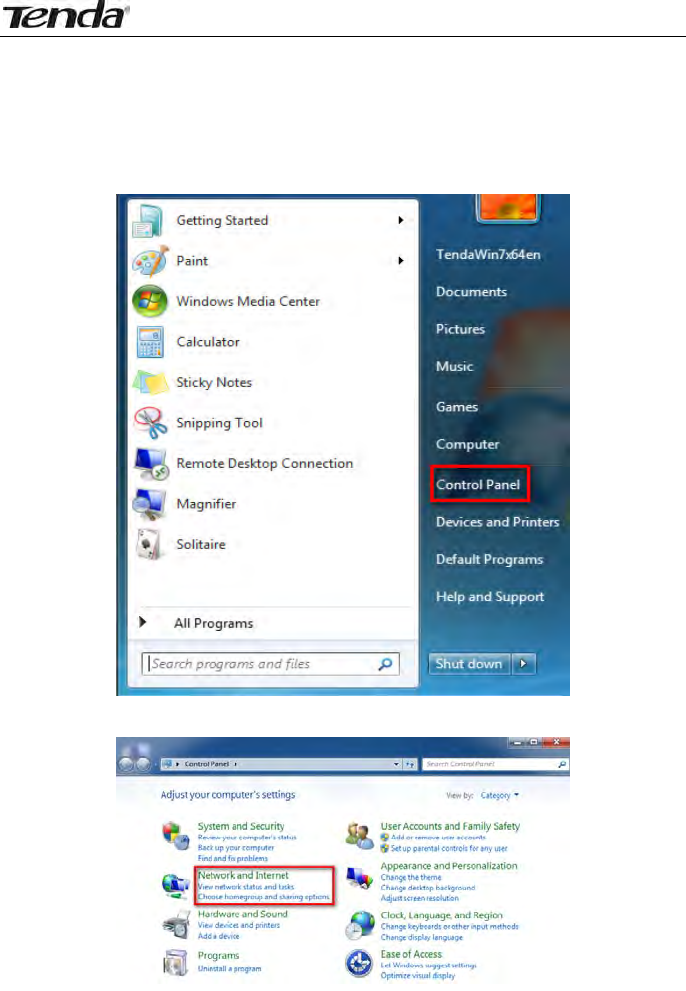
Wireless N300 Easy Setup Router
69
Appendix 1 How to Configure IP
WIN7 OS Configuration
1. Click Start>Control Panel;
2. Enter Control Panel and click Network and Internet;
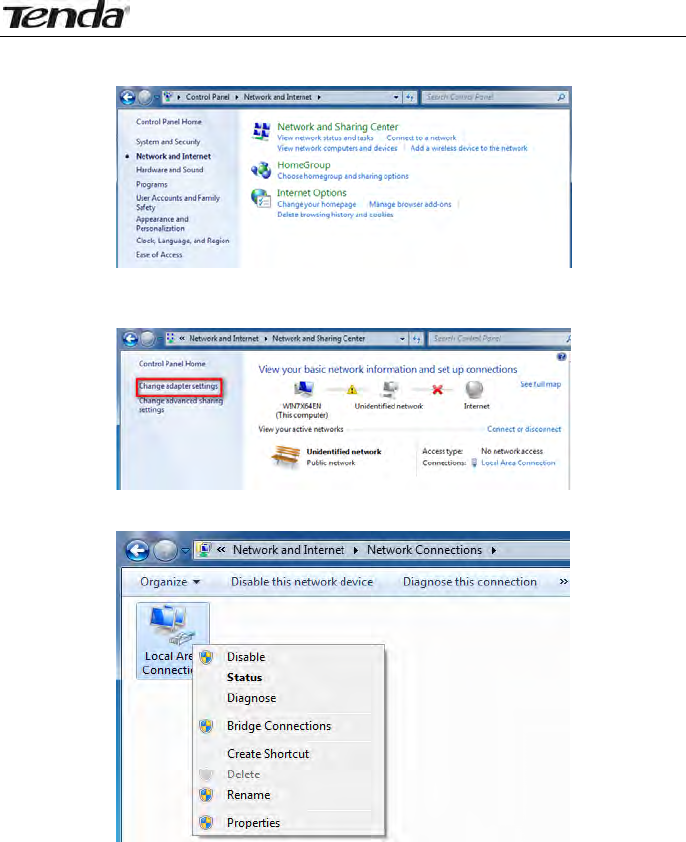
Wireless N300 Easy Setup Router
70
3. Click Network and Sharing Center;
4. Click Change adapter settings;
5. Right click Local Area Connection and select Properties;
6. Select Internet Protocol Version 4(TCP/IPv4) and click Properties;
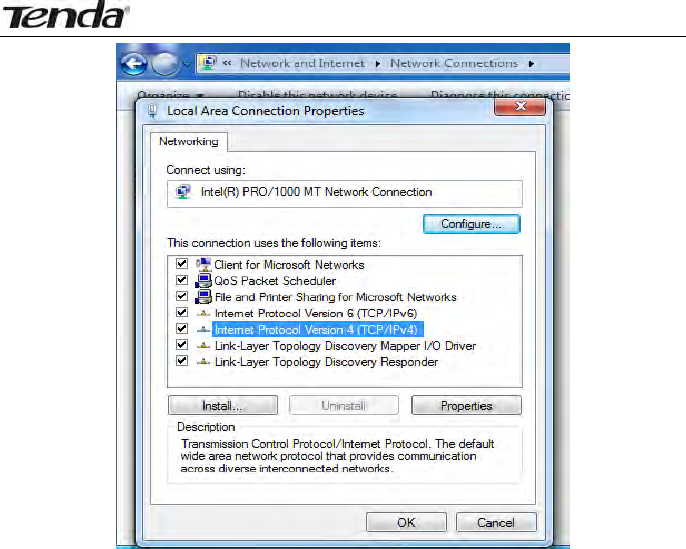
Wireless N300 Easy Setup Router
71
7. Select Obtain an IP address automatically and click OK to save the
configurations.
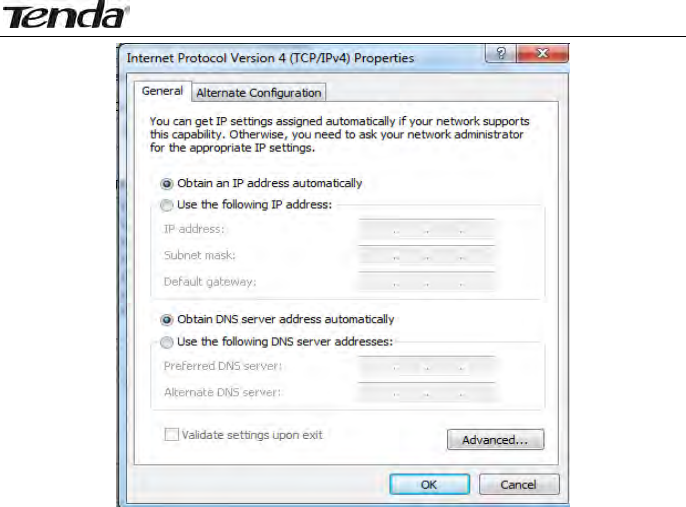
Wireless N300 Easy Setup Router
72
XP OS Configuration
1. Right click My Network Places and select Properties;
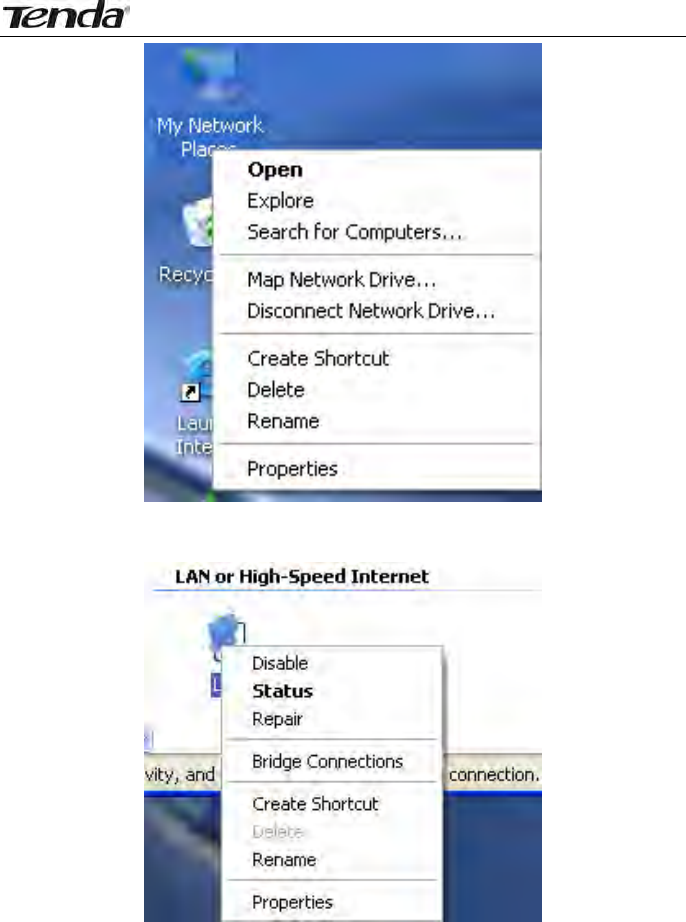
Wireless N300 Easy Setup Router
73
2. Right click Local and select Properties;
3. Select Internet Protocol(TCP/IP) and click Properties;
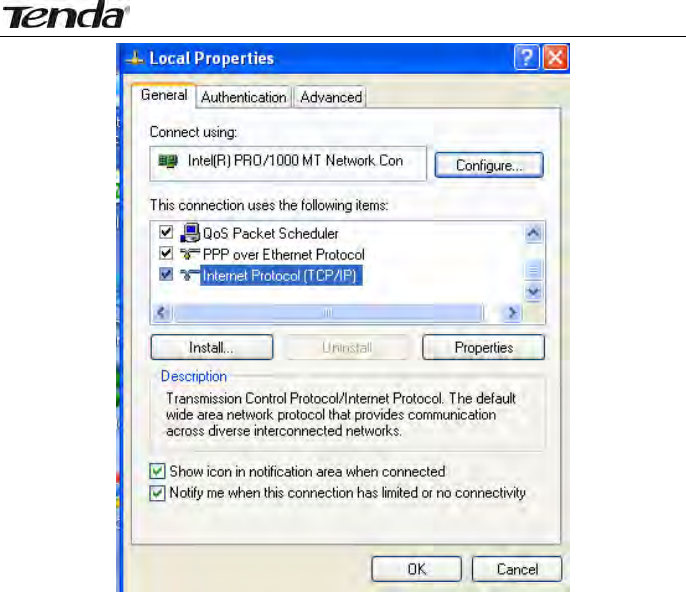
Wireless N300 Easy Setup Router
74
4. Select Obtain an IP address automatically and click OK to save the
settings.
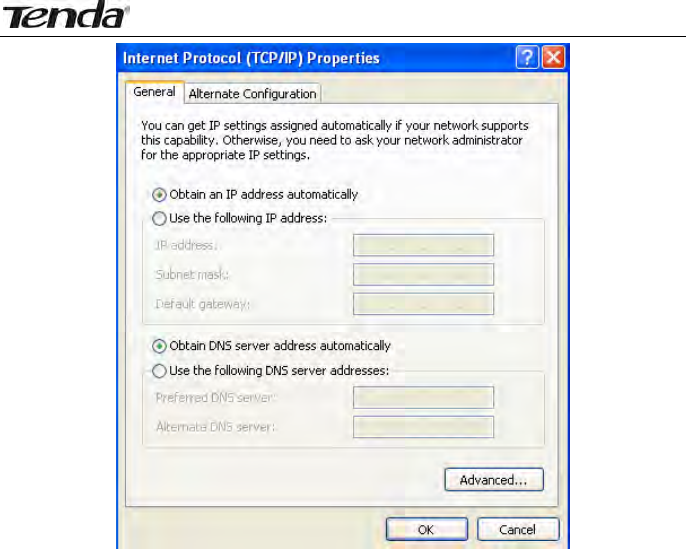
Wireless N300 Easy Setup Router
75

Wireless N300 Easy Setup Router
76
Appendix 2 Glossary
Channel
A communication channel, also known as channel, refers either to a
physical transmission medium such as a wire or to a logical connection
over a multiplexed medium such as a radio channel. It is used to transfer
an information signal, such as a digital bit stream, from one or more
transmitters to one or more receivers. If there is only one AP in the range,
select any channel you like. The default is Auto.
If there are several APs coexisting in the same area, it is advisable that
you select a different channel for each AP to operate on, minimizing the
interference between neighboring APs. For example, if 3 American-
standard APs coexist in one area, you can set their channels respectively
to 1, 6 and 11 to avoid mutual interference.
SSID
Service set identifier (SSID) is used to identify a particular 802.11
wireless LAN. It is the name of a specific wireless network. To let your
wireless network adapter roam among different APs, you must set all
APs’ SSID to the same name.
WPA/WPA2
The WPA protocol implements the majority of the IEEE 802.11i standard.
It enhances data encryption through the Temporal Key Integrity Protocol
(TKIP) which is a 128-bit per-packet key, meaning that it dynamically
generates a new key for each packet. WPA also includes a message
integrity check feature to prevent data packets from being hampered
with. Only authorized network users can access the wireless network.
The later WPA2 protocol features compliance with the full IEEE 802.11i
standard and uses Advanced Encryption Standard (AES) in addition to
TKIP encryption protocol to guarantee better security than that provided
by WEP or WPA. Currently, WPA is supported by Windows XP SP1.
IEEE 802.1X Authentication
IEEE 802.1X Authentication is an IEEE Standard for port-based Network
Access Control (PNAC). It is part of the IEEE 802.1 group of networking
protocols. It provides an authentication mechanism to devices wishing to
attach to a LAN or WLAN.IEEE 802.1X defines the encapsulation of EAP
over LAN or EAPOL. 802.1X authentication involves three parties: a

Wireless N300 Easy Setup Router
77
supplicant, an authenticator, and an authentication server. The supplicant
is a client device (such as a laptop) that wishes to attach to the
LAN/WLAN - though the term 'supplicant' is also used interchangeably to
refer to the software running on the client that provides credentials to the
authenticator. The authenticator is a network device, such as an Ethernet
switch or wireless access point; and the authentication server is typically
a host running software supporting the RADIUS and EAP protocols. The
authenticator acts like a security guard to a protected network. The
supplicant (i.e. client device) is not allowed access through the
authenticator to the protected side of the network until the supplicant’s
identity has been validated and authorized. With 802.1X port-based
authentication, the supplicant provides credentials, such as user name /
password or digital certificate, to the authenticator, and the authenticator
forwards the credentials to the authentication server for verification. If
the authentication server determines the credentials are valid, the
supplicant (client device) is allowed to access resources located on the
protected side of the network.
PPPOE
The Point-to-Point Protocol over Ethernet (PPPoE) is a network protocol
for encapsulating PPP frames inside Ethernet frames. Integrated PPP
protocol implements authentication, encryption, and compression
functions that traditional Ethernet cannot provide and can also be used
in the cable modem and digital subscriber line (DSL) and Ethernet that
provide access service to the users. Essentially, it is a protocol that
allows to establish a point-to-point tunnel between two Ethernet
interfaces within an Ethernet broadcast domain.
DNS
The Domain Name System (DNS) is a hierarchical distributed naming
system for computers, services, or any resource connected to the
Internet or a private network. It associates various information with
domain names assigned to each of the participating entities. A Domain
Name Service resolves queries for these names into IP addresses for the
purpose of locating computer services and devices worldwide. An
often-used analogy to explain the Domain Name System is that it serves
as the phone book for the Internet by translating human-friendly
computer hostnames into IP addresses.

Wireless N300 Easy Setup Router
78
WDS
A wireless distribution system (WDS) is a system enabling the wireless
interconnection of access points in an IEEE 802.11 network. It allows a
wireless network to be expanded using multiple access points without
the traditional requirement for a wired backbone to link them. All base
stations in a wireless distribution system must be configured to use the
same radio channel, method of encryption (none, WEP, or WPA) and the
same encryption keys. They may be configured to different service set
identifiers. WDS also requires every base station to be configured to
forward to others in the system. WDS may also be considered a repeater
mode because it appears to bridge and accept wireless clients at the
same time (unlike traditional bridging).WDS may be incompatible
between different products (even occasionally from the same vendor)
since it is not certified by the Wi-Fi Alliance. WDS may provide two
modes of wireless AP-to-AP connectivity:
Wireless bridging, in which WDS APs communicate only with each other
and don't allow wireless clients or stations (STA) to access them.
Wireless repeating, in which APs communicate with each other and with
wireless STAs.
DMZ
In computer security, a DMZ (sometimes referred to as a perimeter
networking) is a physical or logical subnetwork that contains and
exposes an organization's external-facing services to a larger untrusted
network, usually the Internet. The purpose of a DMZ is to add an
additional layer of security to an organization's local area network (LAN);
an external attacker only has access to equipment in the DMZ, rather
than any other part of the network. Hosts in the DMZ have limited
connectivity to specific hosts in the internal network, although
communication with other hosts in the DMZ and to the external network
is allowed. This allows hosts in the DMZ to provide services to both the
internal and external network, while an intervening firewall controls the
traffic between the DMZ servers and the internal network clients. Any
services such as Web servers, Mail servers, FTP servers and VoIP servers,
etc. that are being provided to users on the external network can be
placed in the DMZ.

Wireless N300 Easy Setup Router
79
Appendix 3 FAQs
This section provides solutions to problems that may occur during
installation and operation of the device. Read the following if you are running
into problems. If your problem is not covered here, please feel free to go to
www.tendacn.com to find a solution or email your problems to:
support@tenda.com.cn or support02@tenda.com.cn. We will be more
than happy to help you out as soon as possible.
1. Q: I entered the device’s LAN IP address in the web browser but
cannot access the utility. What should I do?
1) Check whether device is functioning correctly. The SYS LED should blink
a few seconds after device is powered up. If it does not light up, then
some internal faults may have occurred.
2) Verify physical connectivity by checking whether a corresponding port’s
link LED lights up. If not, try a different cable. Note that an illuminated
light does NOT ALWAYS indicate successful connectivity.
3) Run the "ping 192.168.0.1" command. If you get replies from
192.168.0.1, open your browser and verify that Proxy server is disabled.
In case that ping fails, press and hold the "RESET" button on your device
for 7 seconds to restore factory default settings, and then run
"ping192.168.0.1" again.
4) Contact our technical support for help if the problem still exists after you
tried all the above.
2. Q: What should I do if I forget the login password to my device?
A: Reset your device by pressing the Reset button for over 7 seconds. Note:
All settings will be deleted and restored to factory defaults once you
pressed the Reset button.
3. Q: My computer shows an IP address conflict error after having
connected to the device. What should I do?
1) Check if there are other DHCP servers present in your LAN. If there are
other DHCP servers except your router, disable them immediately.
2) The default IP address of the device is 192.168.0.1; make sure this
address is not used by another PC or device. In case that two computers
or devices share the same IP addresses, change either to a different
address.
4. Q: I cannot access Internet and send/receive emails; what should
I do?
This problem mainly happens to users who use the PPPoE or Dynamic IP

Wireless N300 Easy Setup Router
80
Internet connection type. You need to change the MTU size (1492 by
default). In this case, go to “WAN Settings” to change the MTU value
from default 1480 to 1450 or 1400, etc.
5. Q: How do I share resources on my computer with users on
Internet through the device?
To let Internet users access internal servers on your LAN such as e-mail
server, Web, FTP, via the device, use the "Virtual Server" feature. To do so,
follow steps below:
Step 1: Create your internal server, make sure the LAN users can access
these servers and you need to know related service ports, for example, port
number for Web server is 80; FTP is 21; SMTP is 25 and POP3 is 110.
Step 2: Enter Port Forwarding (also called Port Range Forwarding on
some products) screen from device web UI.
Step 3: Complete the Start Port (also called External/Ext Port on some
products) and End Port (also known as Internal Port on some products) fields,
say, 80-80.
Step 4: Input the internal server’s IP address. For example, assuming
that your Web server’s IP address is 192.168. 0.10, then simply input it.
Step 5: Select a proper protocol type: TCP, UDP, or Both depending on
which protocol(s) your internal host is using.
Step 6: Click Enable and save your settings.
For your reference, we collected a list of some well-known service ports
as follows:
Server Protoco
l Service Port
Web Server TCP 80
FTP Server TCP 21
Telnet TCP 23
Net Meeting TCP 1503、1720
MSN Messenger TCP/UD
P
File Send:6891-6900(TCP)
Voice:1863, 6901(TCP)
Voice:1863, 5190(UDP)
PPTP VPN TCP 1723
Iphone5.0 TCP 22555
SMTP TCP 25
POP3 TCP 110
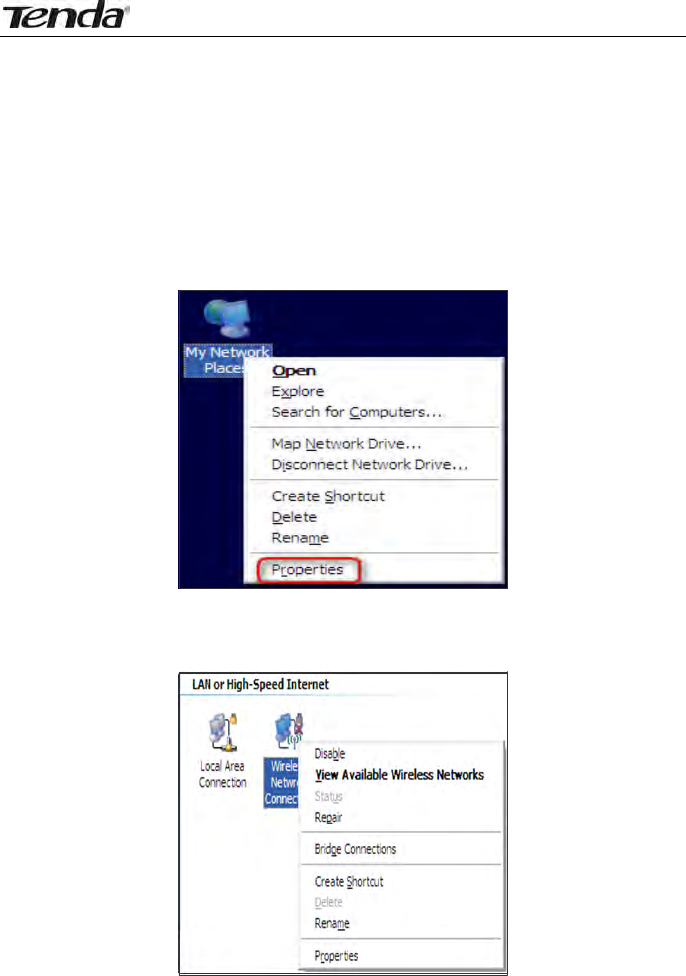
Wireless N300 Easy Setup Router
81
Appendix 4 Remove Wireless Network from Your
PC
If you change wireless settings on your wireless device, you must remove
them accordingly your PC; otherwise, you may not be able to wirelessly
connect to the device. Below describes how to do remove a wireless
network from your PC.
If you are using Windows XP, do as follows:
1. Right click My Network Places and select Properties.
2. Click Wireless Network Connection and then select Properties.
3. Click Wireless Networks, select the item under Preferred networks
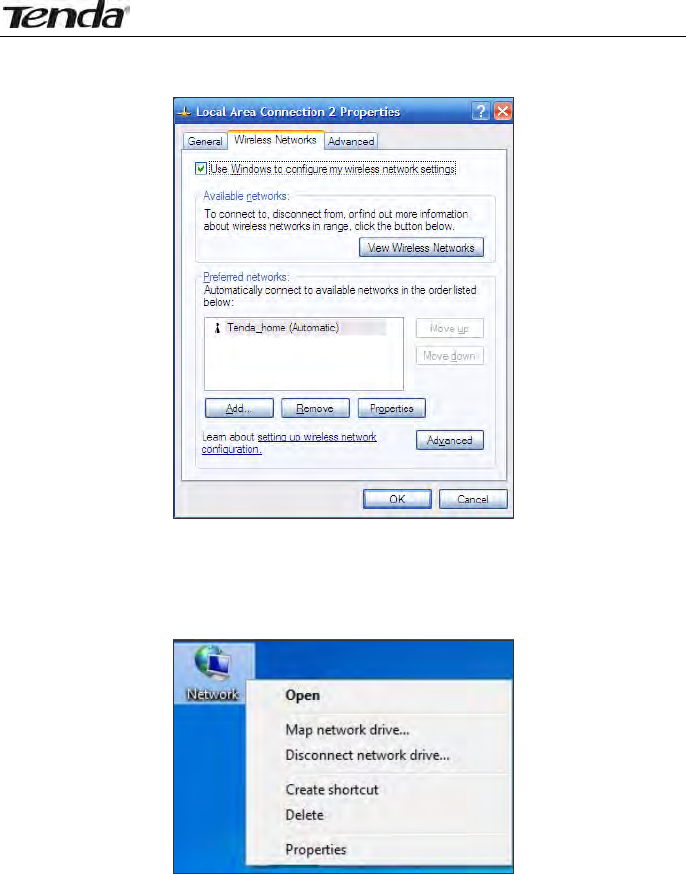
Wireless N300 Easy Setup Router
82
and then click the Remove button.
If you are using Windows 7, do as follows:
1. Click Network from your desktop and select Properties.
2. Select Manage Wireless Networks.
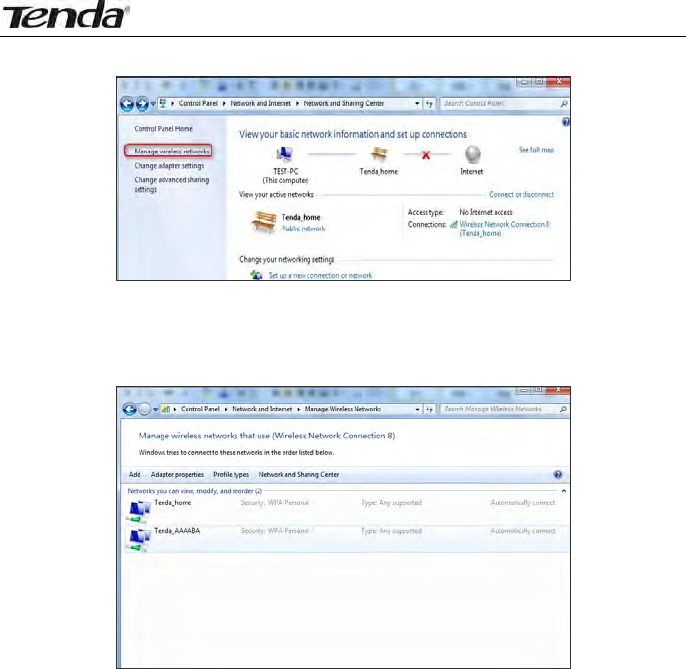
Wireless N300 Easy Setup Router
83
3. Click the wireless connection and select Remove network.

Wireless N300 Easy Setup Router
84
Appendix 5 Safety and Emission Statement
CE Mark Warning
This is a Class B product In a domestic environment, this product may
cause radio interference, in which case the user may be required to take
adequate measures. This device complies with EU 1999/5/EC.
FCC Statement
This device complies with Part 15 of the FCC Rules. Operation is subject
to the following two conditions: (1) This device may not cause harmful
interference, and (2) this device must accept any interference received,
including interference that may cause undesired operation.
This equipment has been tested and found to comply with the limits for a
Class B digital device, pursuant to Part 15 of the FCC Rules. These limits
are designed to provide reasonable protection against harmful
interference in a residential installation. This equipment generates, uses
and can radiate radio frequency energy and, if not installed and used in
accordance with the instructions, may cause harmful interference to
radio communications. However, there is no guarantee that interference
will not occur in a particular installation. If this equipment does cause
harmful interference to radio or television reception, which can be
determined by turning the equipment off and on, the user is encouraged
to try to correct the interference by one of the following measures:
- Reorient or relocate the receiving antenna.
- Increase the separation between the equipment and receiver.
- Connect the equipment into an outlet on a circuit different from that to
which the receiver is connected.
- Consult the dealer or an experienced radio/TV technician for help.
FCC Caution: Any changes or modifications not expressly approved by
the party responsible for compliance could void the user's authority to
operate this equipment.
This transmitter must not be co-located or operating in conjunction with
any other antenna or transmitter.
The manufacturer is not responsible for any radio or TV interference
caused by unauthorized modifications to this equipment.
Radiation Exposure Statement
This equipment complies with FCC radiation exposure limits set forth for an

Wireless N300 Easy Setup Router
85
uncontrolled environment. This equipment should be installed and operated
with minimum distance 20cm between the radiator & your body.
Note:
1. The manufacturer is not responsible for any radio or TV interference
caused by unauthorized modifications to this equipment.
2. To avoid unnecessary radiation interference, it is recommended to use a
shielded RJ45 cable
IC RSS warning
This device complies with Industry Canada licence-exempt RSS
standard (s). Operation is subject to the following two conditions: (1) this
device may not cause interference, and (2) this device must accept any
interference,including interference that may cause undesired operation of
the device.
Le présent appareil est conforme aux CNR d'Industrie Canada
applicables aux appareils radio exempts de licence.
L'exploitation est autorisée aux deux conditions suivantes:
(1) l'appareil ne doit pas produire de brouillage, et
(2) l'utilisateur de l'appareil doit accepter tout brouillage radioélectrique
subi, même si le brouillage est susceptible d'en compromettre le
fonctionnement.
Under Industry Canada regulations, this radio transmitter may only
operate using an antenna of a type and maximum (or lesser) gain approved
for the transmitter by Industry Canada. To reduce potential radio
interference to other users, the antenna type and its gain should be so
chosen that, the equivalent isotropically radiated power (e.i.r.p.) is not more
than that necessary for successful communication.
Conformément à la réglementation d'Industrie Canada, le présent
émetteur radio peut fonctionner avec une antenne d'un type et d'un gain
maximal (ou inférieur) approuvé pour l'émetteur par Industrie Canada.
Dans le but de réduire les risques de brouillage radioélectrique à l'intention
des autres utilisateurs, il faut choisir le type d'antenne et son gain de sorte
que la puissance isotrope rayonnée équivalente (p.i.r.e.) ne dépasse pas
l'intensité nécessaire à l'établissement d'une communication satisfaisante.
The device meets the exemption from the routine evaluation limits in
section 2.5 of RSS 102 and compliance with RSS-102 RF exposure, users can
obtain Canadian information on RF exposure and compliance.
Le dispositif rencontre l'exemption des limites courantes d'évaluation dans
la section 2.5 de RSS 102 et la conformité à l'exposition de RSS-102 rf,
utilisateurs peut obtenir l'information canadienne sur l'exposition et la
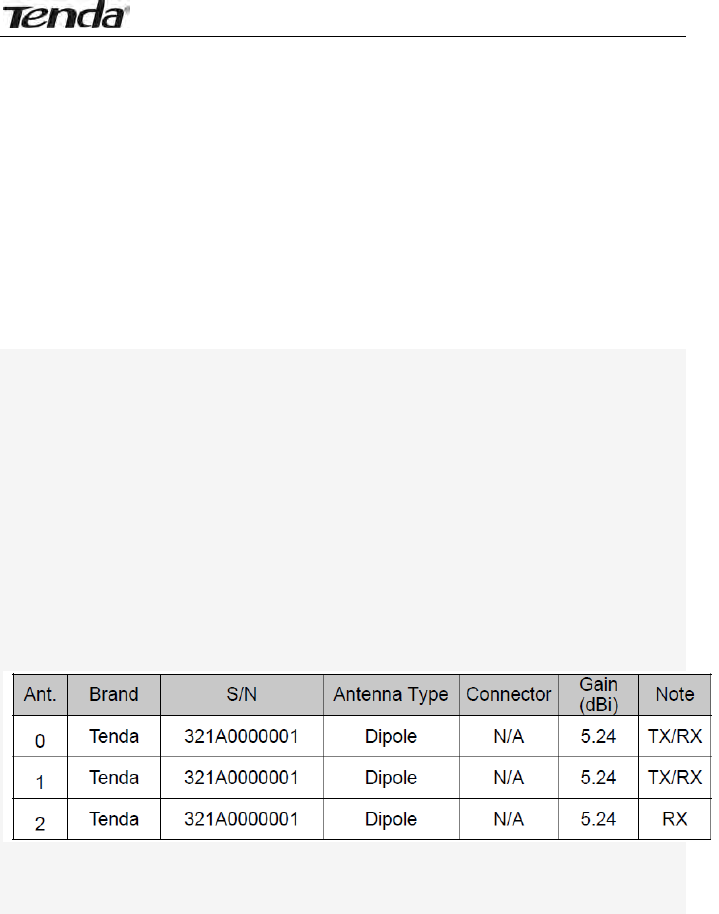
Wireless N300 Easy Setup Router
86
conformité de rf.
Cet émetteur ne doit pas être Co-placé ou ne fonctionnant en même
temps qu'aucune autre antenne ou émetteur.
This equipment should be installed and operated with a minimum
distance of 20 centimeters between the radiator and your body.
Cet équipement devrait être installé et actionné avec une distance minimum
de 20 centimètres entre le radiateur et votre corps.
IC Radiation Exposure Statement:
This equipment complies with IC RF radiation exposure limits set forth
for an uncontrolled environment. This transmitter must not be co-located or
operating in conjunction with any other antenna or transmitter.
IC Déclaration sur la radioexposition:
Cet équipement est conforme aux limites d'exposition aux rayonnements RF
IC énoncées pour un environnement non contrôlé. Cet émetteur ne doit pas
être co-localisées ou opérant en conjonction avec une autre antenne ou
transmetteur.
This radio transmitter (IC: 9034A-W303RV3) has been approved
by Industry Canada to operate with the antenna types listed below with
the maximum permissible gain and required antenna impedance for
each antenna type indicated. Antenna types not included in this list,
having a gain greater than the maximum gain indicated for that type,
are strictly prohibited for use with this device.Antenna listed as below:
Manufacturer: SHENZHEN TENDA TECHNOLOGY CO.,LTD.